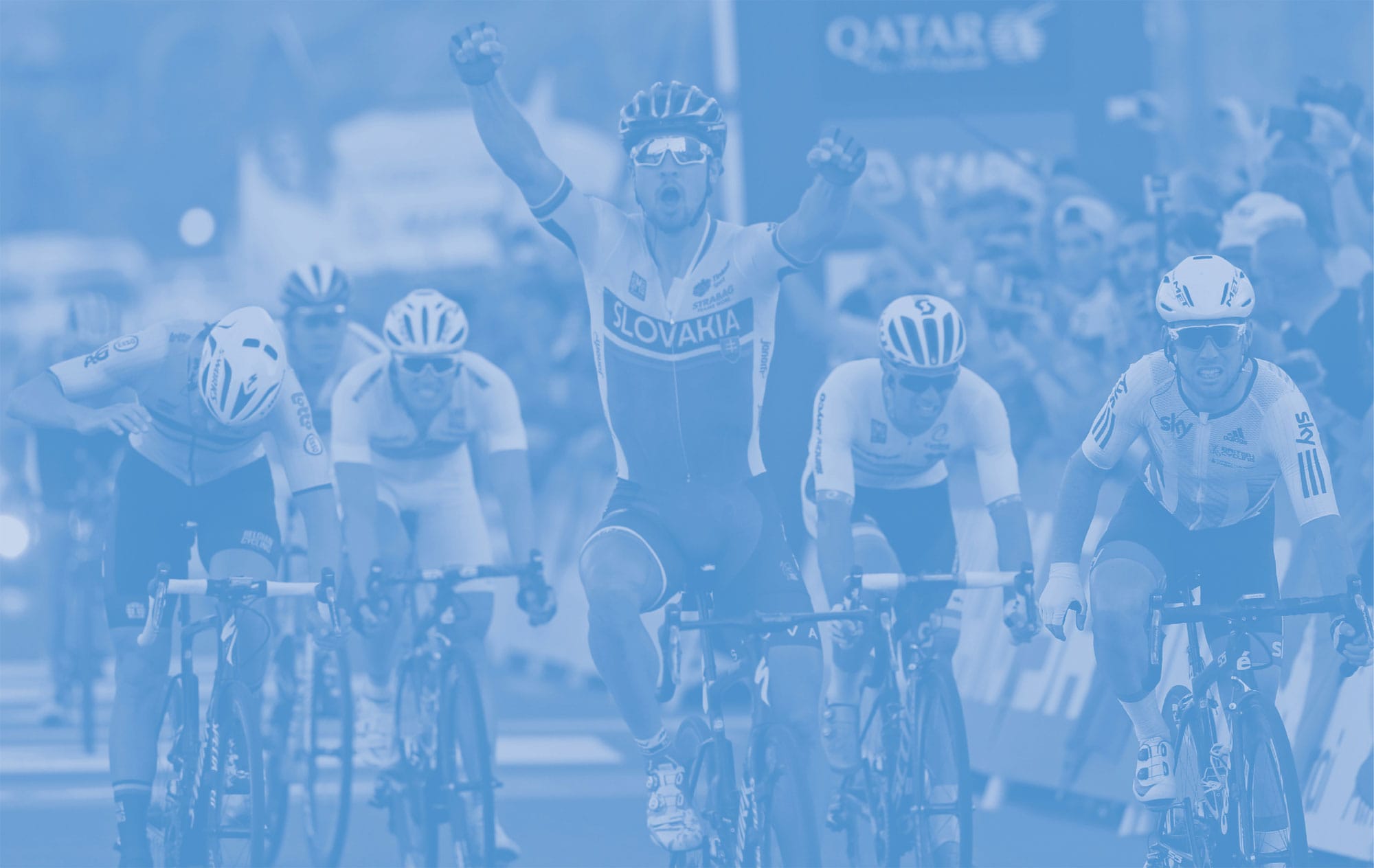chapter six
the human factor
This chapter is about you and how you can become a better cyclist. It explains how the different systems of your body function and how, when treated carefully, they can be improved to work together and give you a better cycling experience. You don’t have to go faster or farther but you can raise your ambitions by knowing something about the possibilities revealed by science. It’s a happy coincidence that cyclists have become the preferred lab rats of sports science. The bicycle ergometer is a convenient way to run repeatable, controlled experiments indoors, with the participant in a position that allows them to be easily monitored. Every year, scores of volunteers are wired up by researchers and set off on stationary time trials. The knowledge gained has helped deepen our understanding of physiology and endurance, and we are constantly finding out more as fresh results are published. There is a lot more to learn, but this chapter will tell you enough about yourself to make your cycling even more rewarding.

How does a cyclist’s body work?
 Am I a machine?
Am I a machine?
The bicycle both constrains and liberates the body, restricting our choice of postures so our maximum power can flow freely. But unlike the bike, most of our components are hidden and are infinitely more sophisticated. Understanding how our body works helps us as cyclists to ride farther, faster, and for longer without tiring.
The human body contains a host of complex, collaborative, and interdependent systems. Of most interest to cyclists are the nervous, musculoskeletal, circulatory, respiratory, and skin systems. All these systems work together. For example, when a rider wants to speed up, a message from the brain instructs the quadriceps muscles to work harder, which places a greater demand on the heart to supply oxygenated blood fresh from the lungs. As the rider turns the pedals more quickly, the extra work raises their temperature, so the skin produces sweat to keep the body cool. For the rider, all this happens automatically but, just like the bike, there are limits to the performance of each part so an awareness of how they function and what they do increases the cyclist’s ability to get full potential from each part.
A bicycle’s components can be updated separately for better specific performance, but a key difference between man and machine is that training improves all of the human body; most exercise has a holistic impact. It’s obvious that leg muscles develop more than arms through cycling, but there are also invisible benefits for the cardiovascular and respiratory systems. Likewise, sprinting practice not only promotes muscle growth suitable for sudden acceleration but may also quicken reactions. The vast number of physiological and biochemical activities, from the obvious leg movements to submicroscopic nutrient metabolization, can be tuned and trained to make cycling faster, easier, and more rewarding.
How does my brain help me ride?
 Can I swerve like a pro racer?
Can I swerve like a pro racer?
Picture this. Riding with friends on an open road, the wind in your hair, warm sun on your face, the sweet scent of blossom in the air, and the quiet hum of tires on the blacktop. A rider falls into your path and you instinctively steer around them. How did you react so quickly?
All the body’s activities are coordinated by the nervous system, which is made up billions of nerve cells, called neurons, which are interconnected and controlled by the brain. The brain receives and processes information from all parts of the body and sends back instructions. Information travels between neurons in waves of chemical and electrical changes, using potassium and sodium ions to create signals, called nerve impulses. They trigger our reactions, so that we can avoid riding into fallen companions.
There are two components to every physical reaction—the time it takes for the nervous system and brain to identify that there’s a hazard, and the time it takes for the muscles to move. It is well known that being fit means that you react faster—and that you react faster still while exercising. By monitoring pedaling riders, scientists discovered that the ability of the nervous system and brain to react does not speed up at all. The instructions still travel at 358 mph (160 m/s) during exercise—it’s the muscles that react more quickly if they are exercising.
It’s as if muscle tissue is more alert while exercising. In fact, muscle reaction time improves by more than 15 percent while you are exercising.2 So when the sensory neurons relay to the brain information captured by the eyes showing that there is a hazard on the road, the brain sends an impulse through motor neurons to make the arm and hand muscles turn the handlebars in good time to avoid a collision.
Reaction times of fit and unfit riders
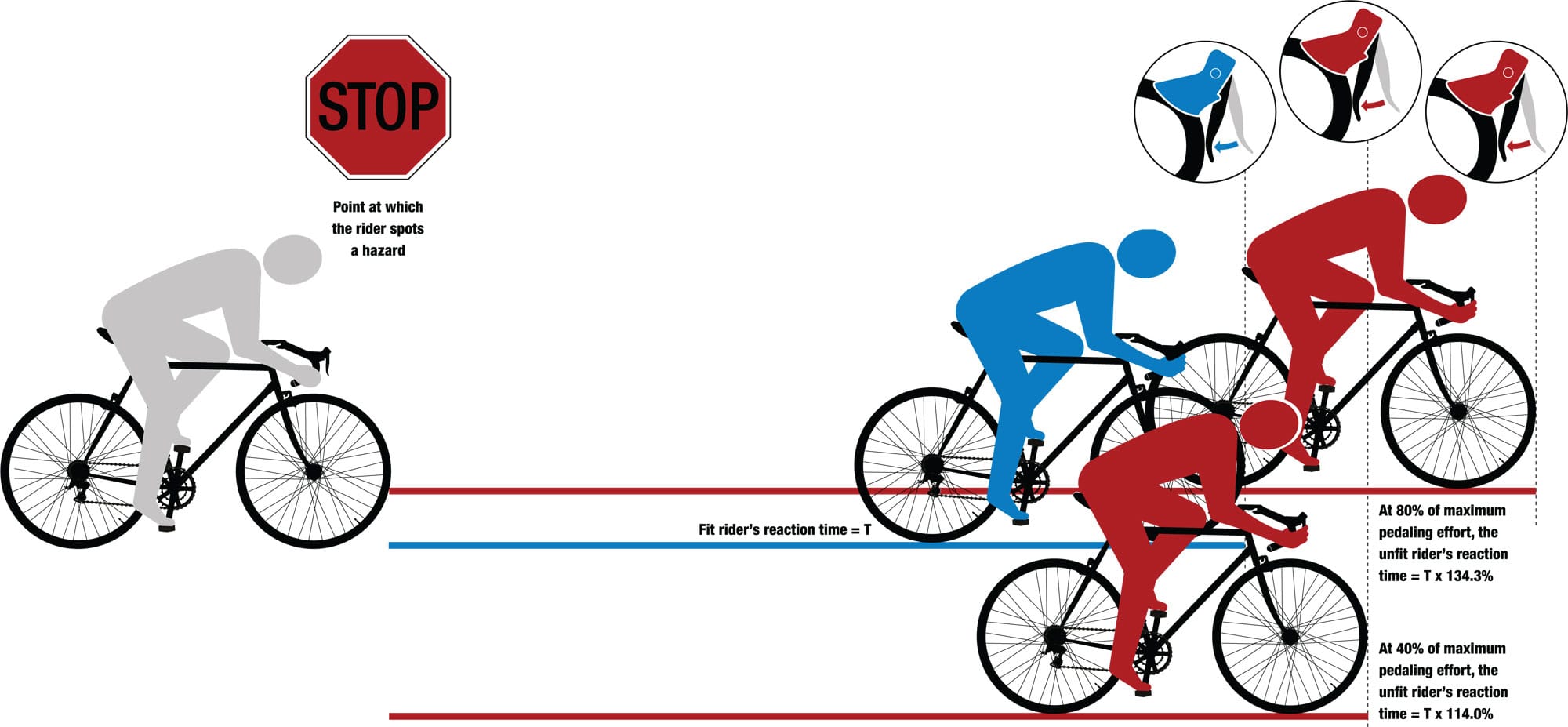
Fit for purpose The reaction times of fit riders are significantly faster than those of less fit riders. It’s a physiological improvement brought about through a regular, good level of exercise. The reaction time differences are measured in tens of milliseconds, but that’s long enough to avoid a collision with a sudden obstacle. A rider who hasn’t exercised is significantly slower to react and less able to avoid the hazard.4
Coming up behind
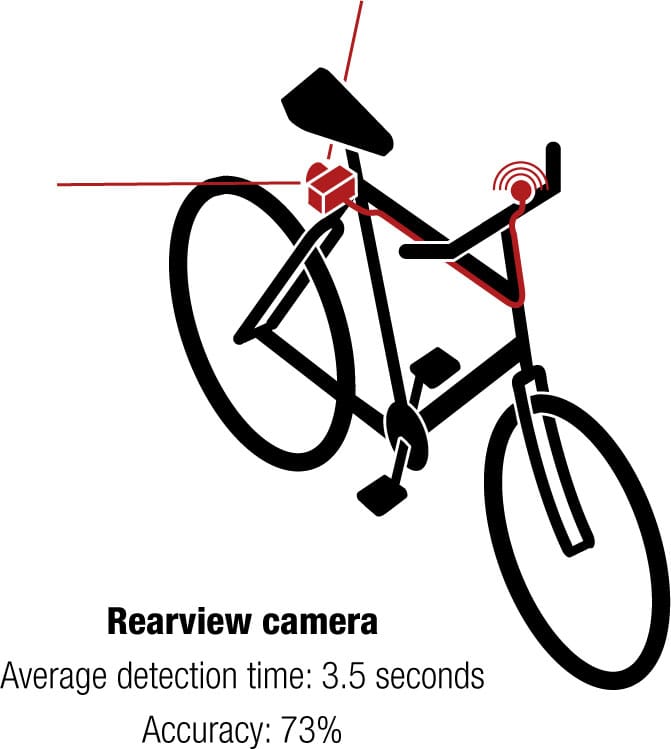
Sixth sense Technology could give cyclists more time to react by detecting events that human senses cannot. Cyclists don’t have eyes in the back of their head and can’t always hear vehicles approaching from behind, but two trials of new technology could change all that. The first was a rearview camera with computing power to flash an alert on the bike’s computer whenever a vehicle approached from behind.5 The second trial used a similar system but instead of vision it detected approaching vehicles by their sound.6
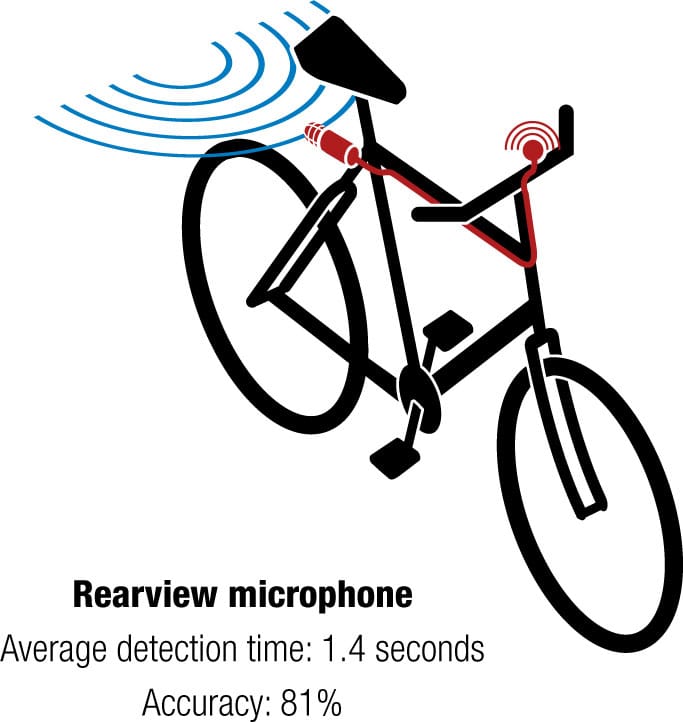
How do a cyclist’s muscles behave?
 Where do I need to bulge most?
Where do I need to bulge most?
Skeletal muscles make our bodies move, mostly by articulating our joints. They react to nerve impulses that turn thought into action. Muscle tissue can exert only a pulling force; it cannot push and so, fortunately, the cyclic aspect of pedaling gives each muscle a chance to recover before the next stroke. At the ends of each muscle, connective tissue sheaths meld together to form tendons, which are anchored to bone. A tendon behaves like a spring to modify the forces, so our muscle and bone are less likely to develop damage if we work them too hard. Nonetheless, vigorous weight training can double or triple muscle size (but disuse can shrink muscle size by 20 percent in two weeks).7 Used intelligently, muscles can get a mountain biker up a steep hillside or propel a sprinter across the winning line at 35 mph (55 km/h).
The main cycling muscles are in the calf in the lower leg and the quadriceps and hamstrings in the upper leg. These muscles contract in a sequence that lifts the leg at the hip, bends the knee, and flexes the ankle to create the pedaling action. The demands on each muscle change as the rider pedals and also when the rider adjusts his or her position for best comfort, aerodynamics or power. The most significant change happens when the rider stands on the pedals to maximize power, such as when attacking a climb. Then, the gluteus maximus in the buttock has to work harder on the upstroke to lift the leg. Also, the tibialis anterior at the front of the shin greatly increases in effort to raise the foot, which has flexed more at the ankle, and to be ready to transmit the pedaling down force again.
Power drivers
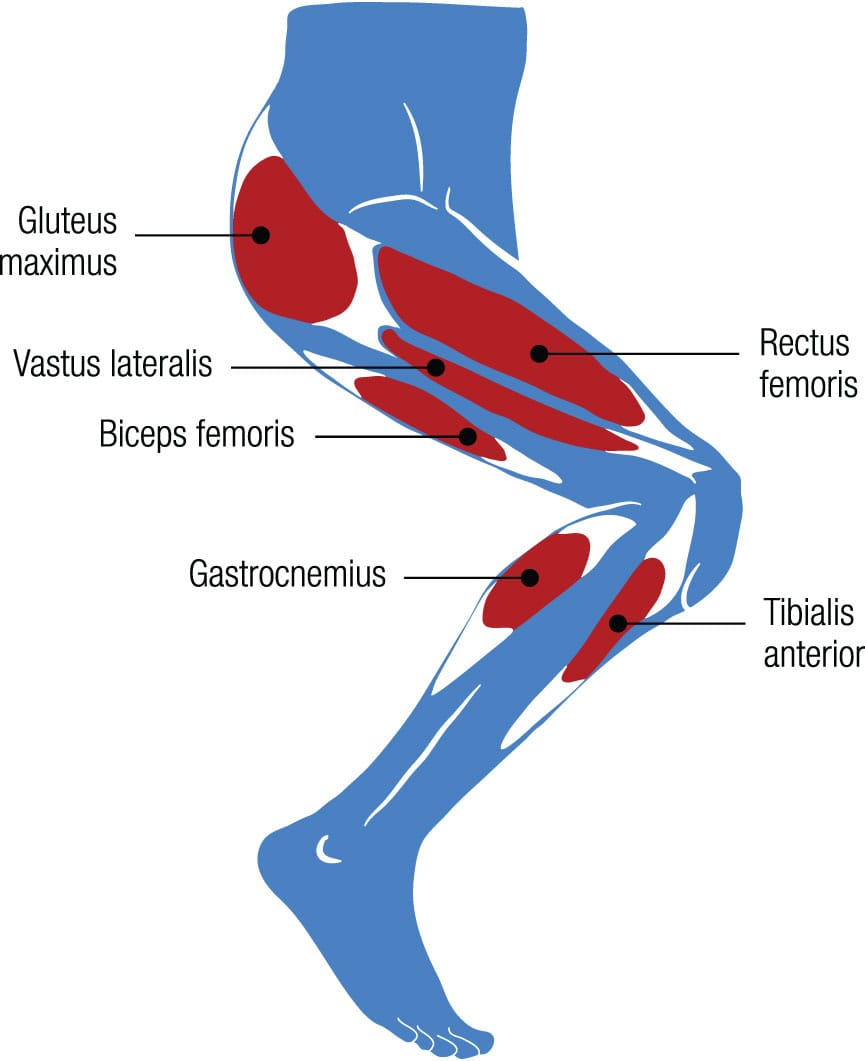
Muscle use during a climb (standing and seated)
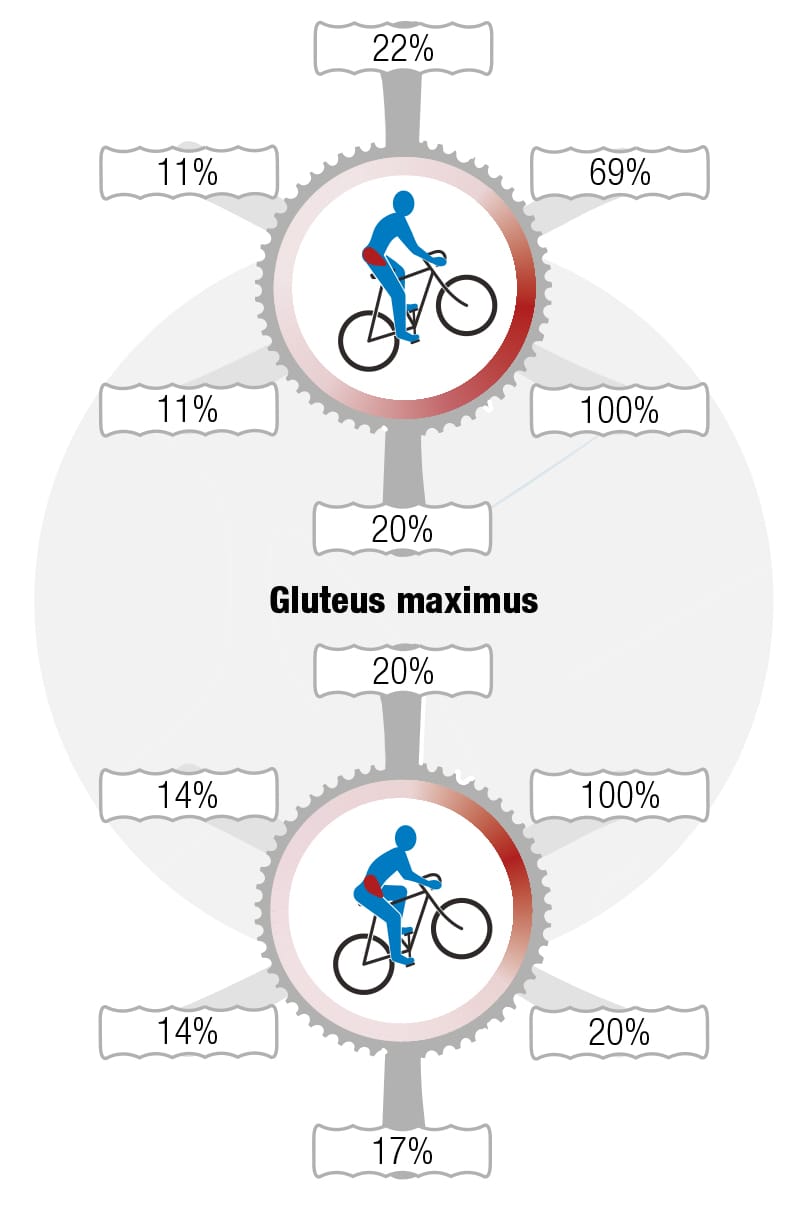
Rising power Climbing hills demands more work, and sometimes it’s necessary to stand on the pedals to produce enough force and maintain speed. This calls for a change in the effort from muscles because of the changes in posture, and the weight of the body has to be carried by the legs instead of the saddle. Different muscles peak in their use at different points in the rotation of the cranks, but the work done by the gluteus maximus (in the buttock) and tibialis anterior (close to the shinbone) is clearly much greater when standing than when sitting.8
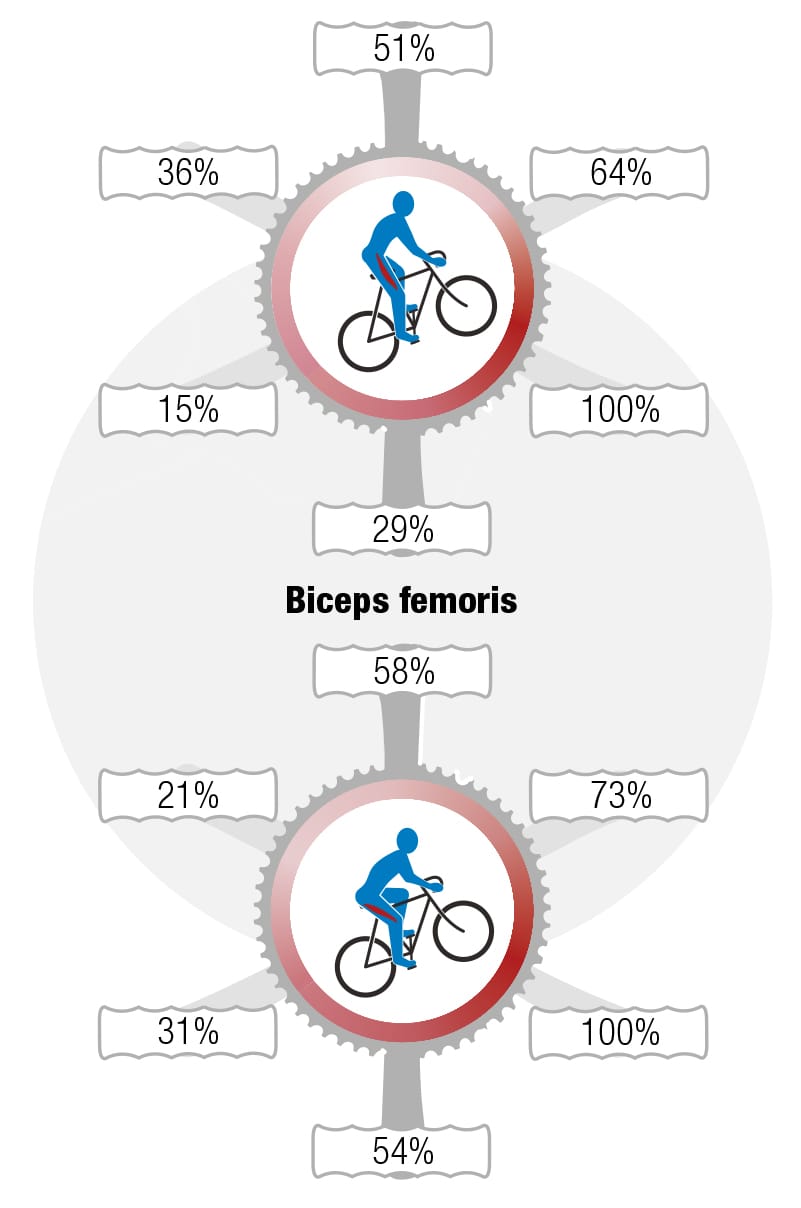
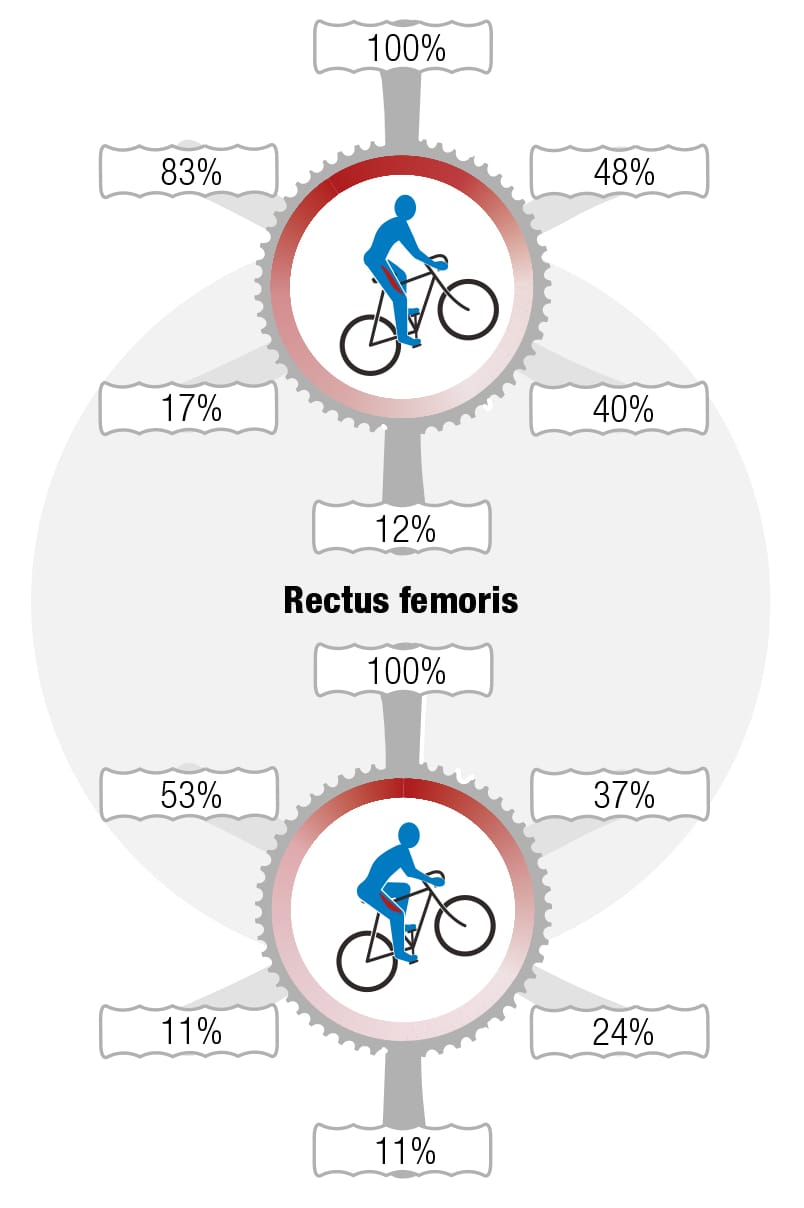
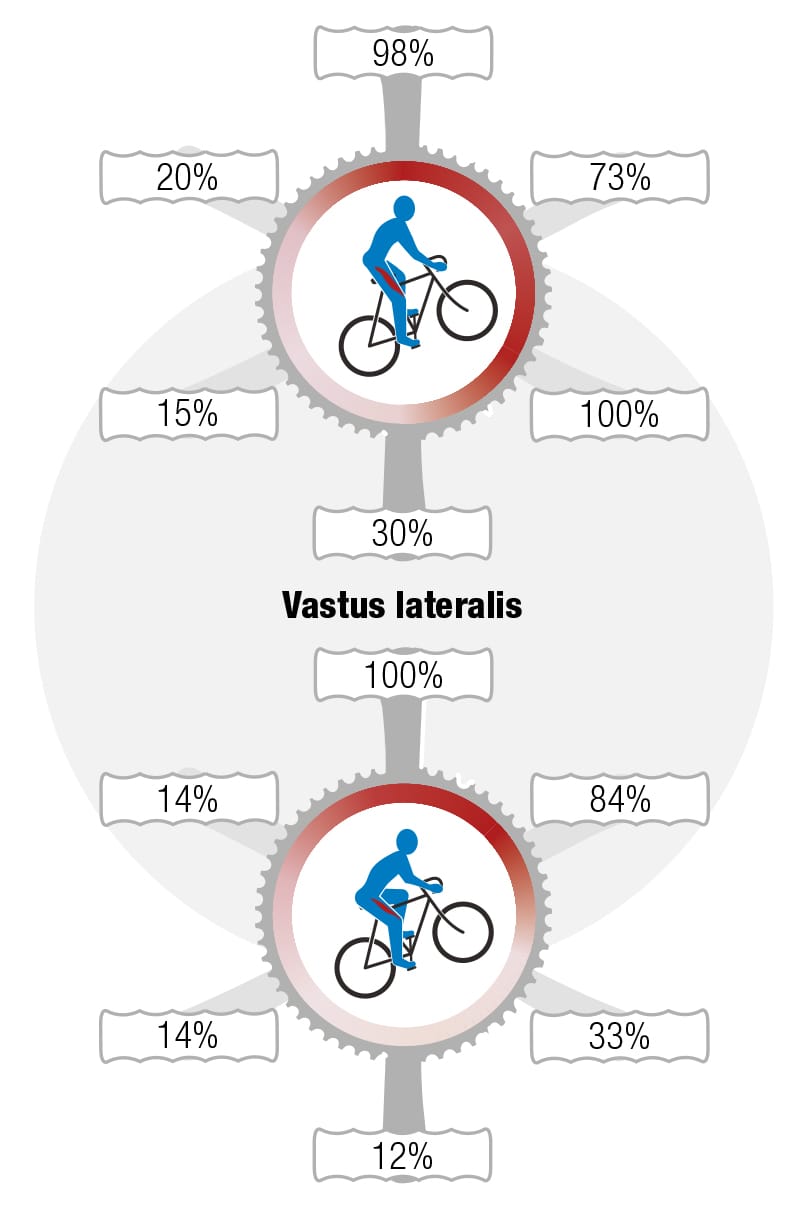
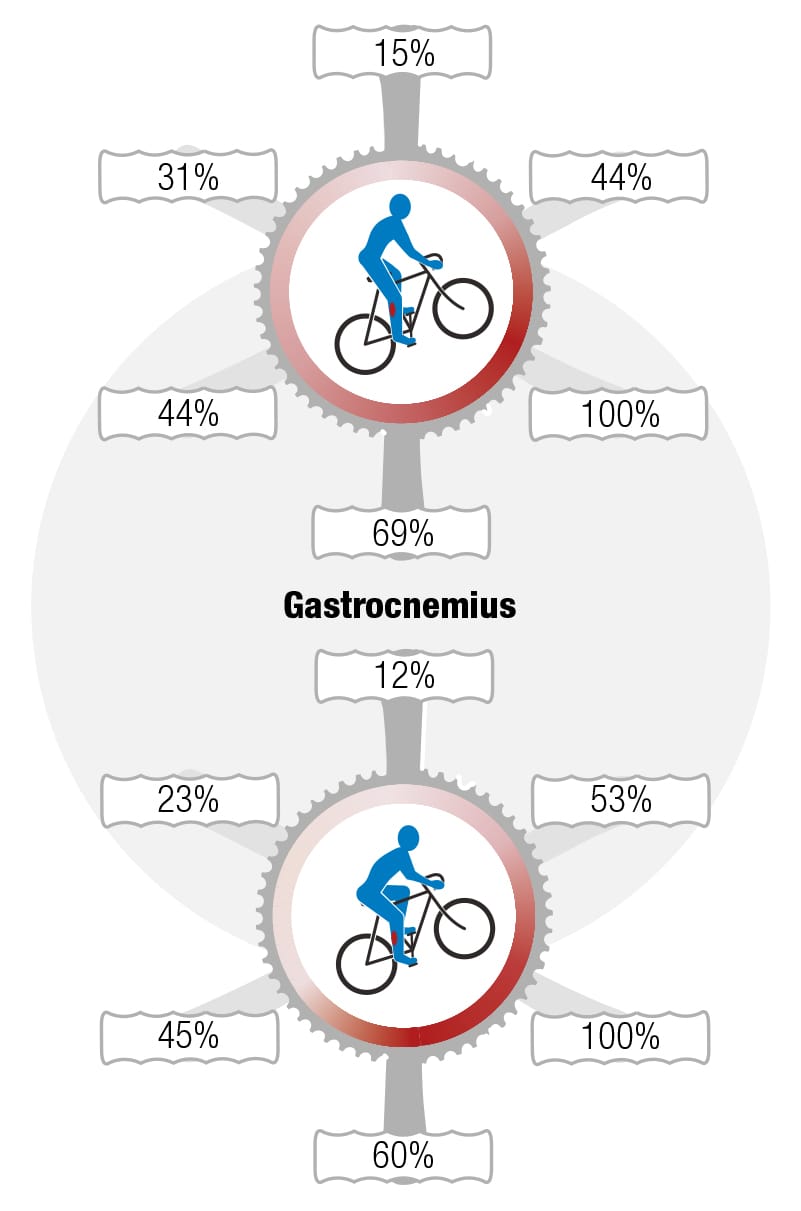
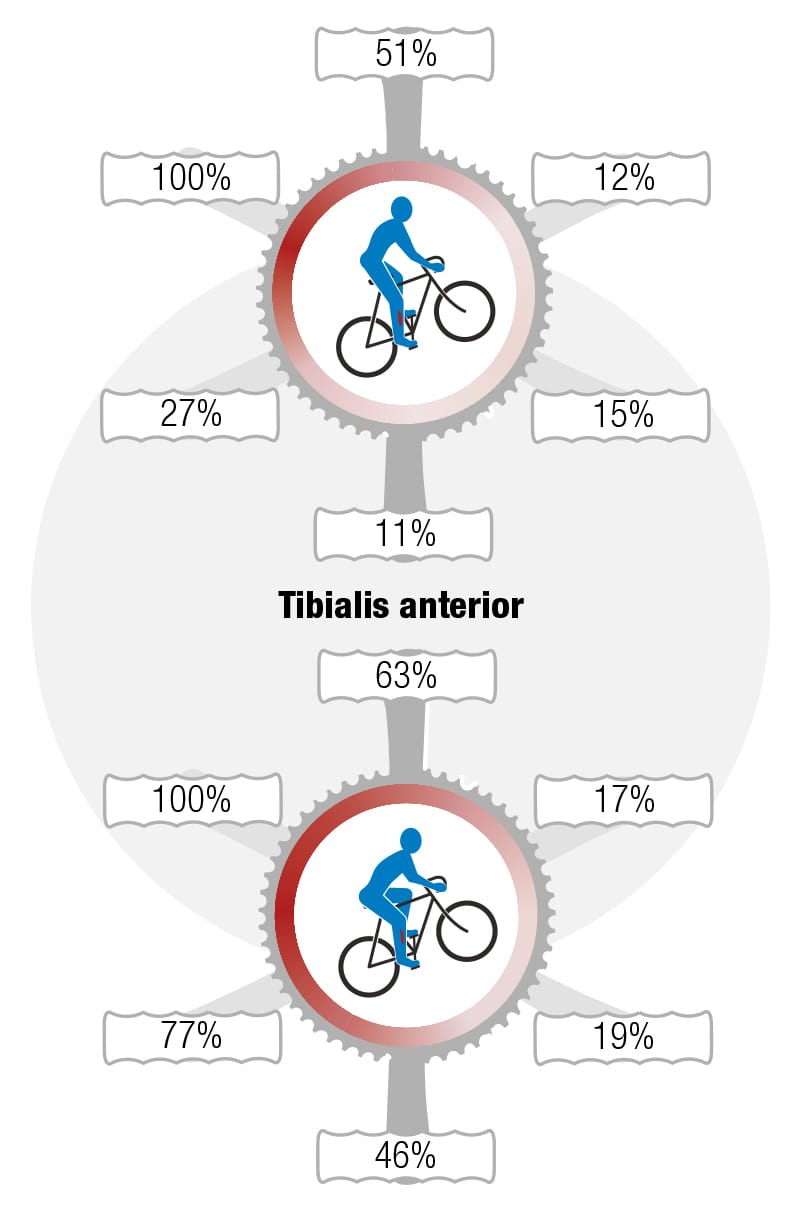
equipment: clothing
“Beware all enterprises that require new clothes,” American philosopher Henry Thoreau warned. Within 30 years of his death, the cycle craze had begun and, with it, a market for new garments that were comfortable, protective, and attractive for cyclists. A nineteenth-century sociopolitical movement, the Rational Dress Society, urged Victorian women to swap their corsets and long skirts for the bloomers and divided skirts that made cycling easier. Natural textiles made of wool, cotton, and leather were replaced by synthetics during the second half of the twentieth century, improving the functionality of cycle clothing. Weight was reduced, and insulation and breathability have increased along with durability and comfort.
Fabric and cut distinguish cycle clothing from other apparel, with sports cyclists wearing the most extreme garments. Close cutting maximizes aerodynamics and stops material from flapping into moving parts. Materials that resist dirt, are impermeable to wind, dry quickly, and retain their shape are favored. Mixtures of natural fibers, such as the Brilliantine cotton and worsted wool of the nineteenth century, were the best options. The first vulcanized rubber was used as rain gear.
Synthetics changed everything. In 1959, scientists developed a polyurethane–polyurea copolymer and branded it as Spandex (Lycra in Europe). By the 1970s, it had replaced the traditional alpaca wool shorts and chamois leather inserts. W.L. Gore and other manufacturers produced breathable, waterproof gear, with pores too small for droplets to enter but large enough for vapor to exit. Textile freshness has been enhanced by a better understanding of bacteria and how to combat them with impregnated deodorizing chemicals. Science has also proved that one natural fiber used for cycling garments can do the same thing without chemical intervention: Merino wool has a combination of microbes and morphology that absorbs and holds odors.9
Protective hats were made first of pith strips and then of leather, evolving quickly into “hairnets.” Today, helmets are mass-produced with hard polymer shells and foam linings that meet certificated impact standards. Buttons may still feature on leisure gear but serious clothing has zippers and Velcro. Race clothing is now skintight and nineteenth-century riders would regard it merely as garish underwear.
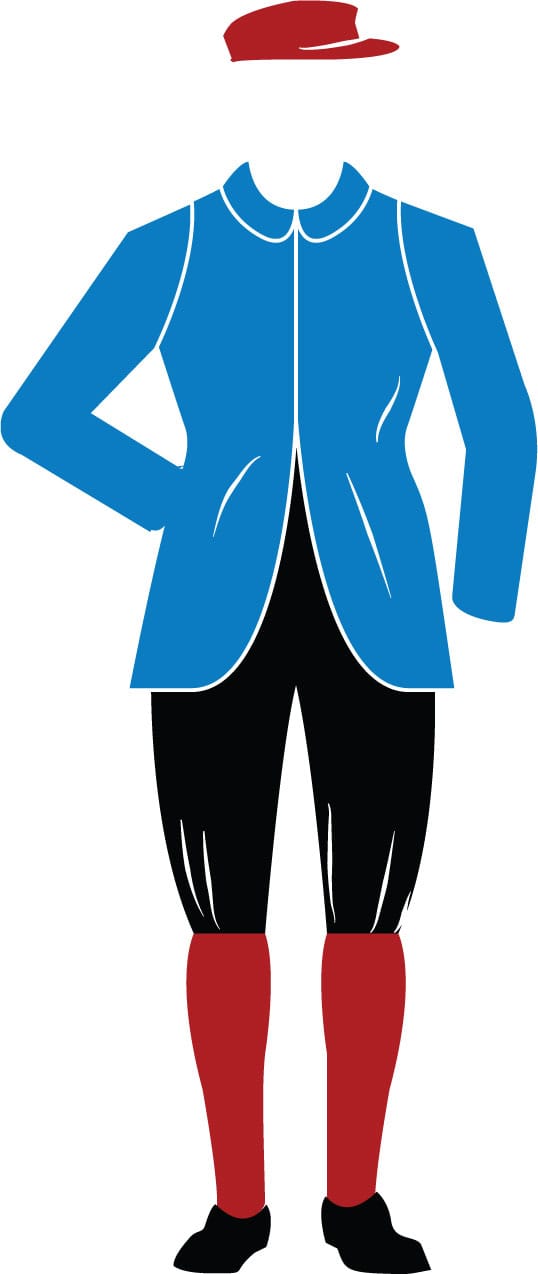
Club class (ca. 1880)
Despite the frequent risk of going headfirst over the front of a high-wheeler, a cloth cap was the only protection donned by the first club men. It’s a garment that has survived largely unchanged since the sport’s inception, although it’s banned from pro competitions.
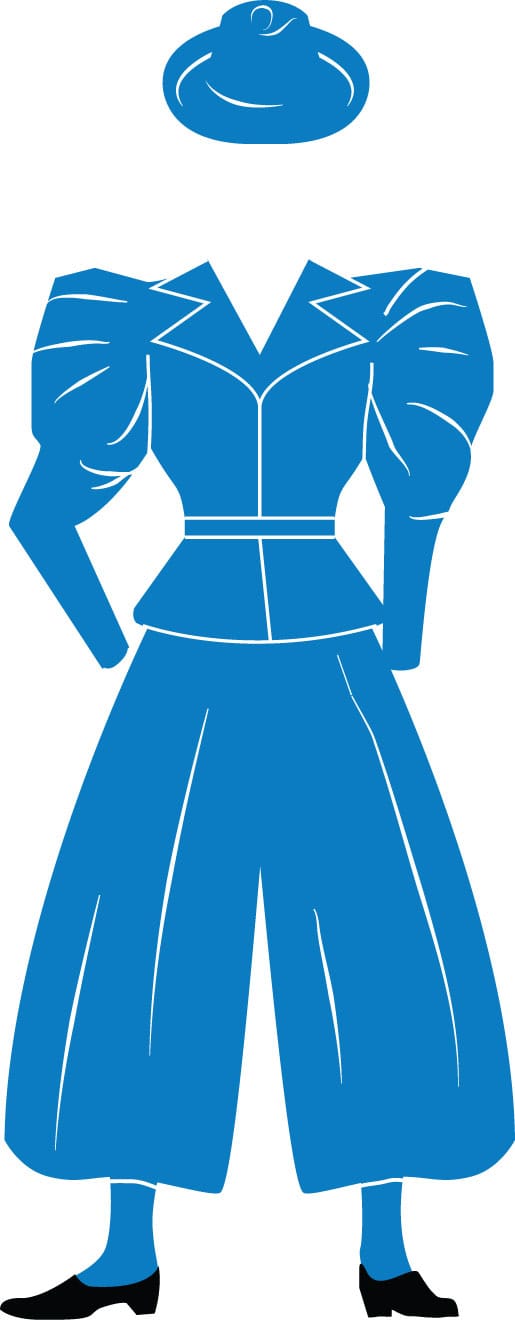
Divide and unrule (1897)
Divided skirts and bloomers, a necessity for safe cycling, were also adopted as a mark of women’s rebellion against the restrictions of nineteenth-century fashion.
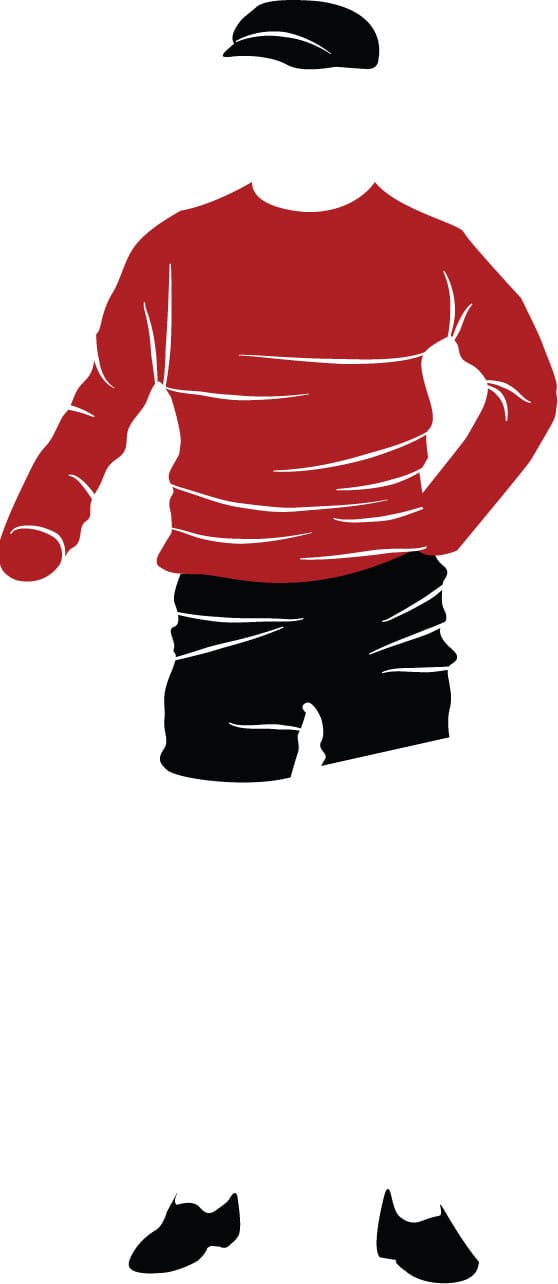
Loose fitting (1925)
The natural fiber clothing worn by Tour de France double winner Ottavio Bottecchia just about kept him warm, but the creases and wrinkles were not aerodynamic.
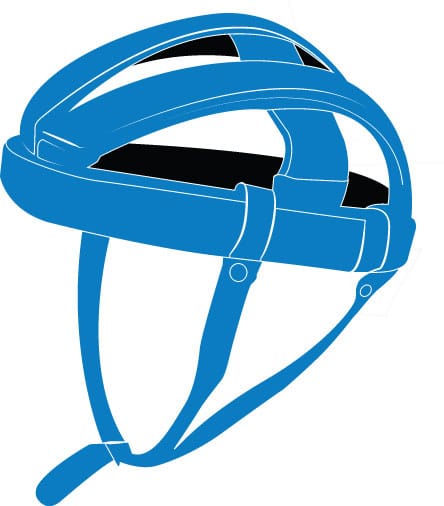
Soft option (ca. 1969)
The padded leather “bunch of bananas” offered riders throughout the twentieth century little more protection than the fruit itself. It weighed little, was well-ventilated, and may have given some a comforting but false sense of security.
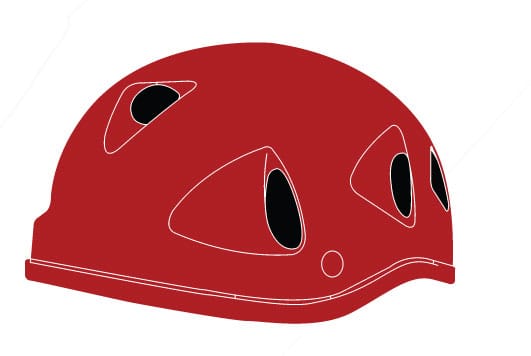
Hard headed (1978)
The first purpose-made plastic shell helmet became available, descendents of which are now mandatory in professional road races. Arguments rage about their benefits and disadvantages for everyday cyclists.
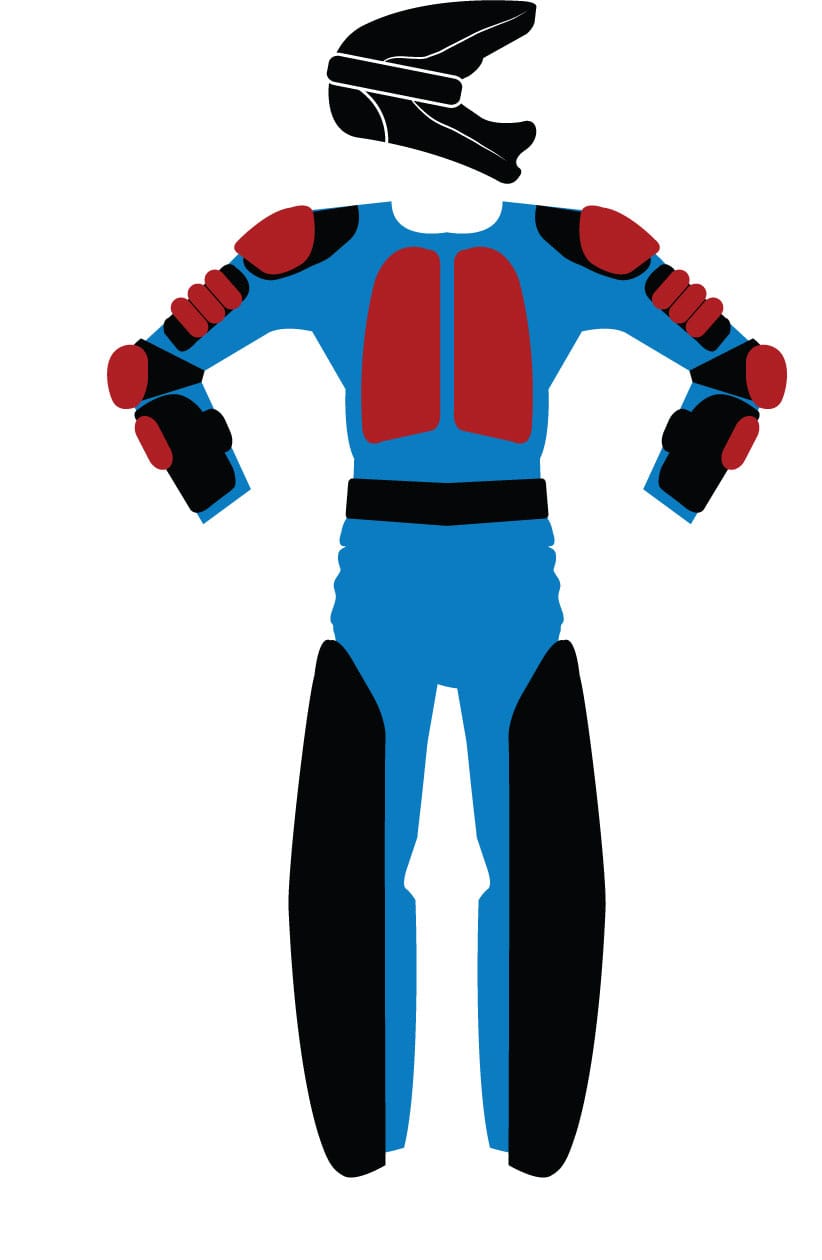
Body armor (2007)
Downhill mountain bikers race down slopes used by skiers in winter, but at a time when there’s no snow to cushion any impacts. Full body armor and visored helmets are needed.
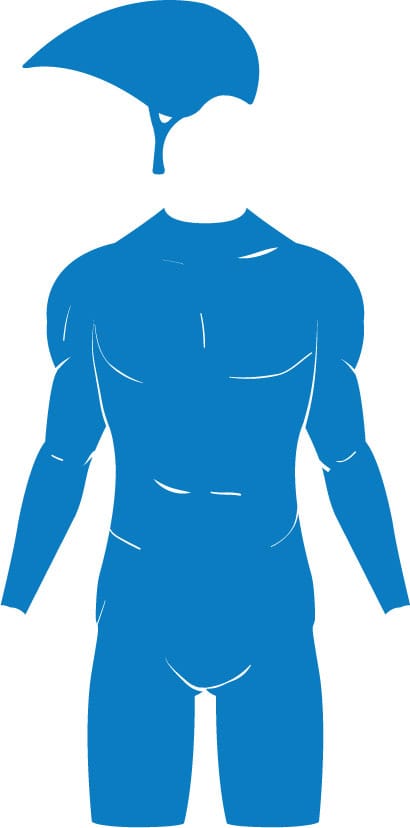
Skintight (2012)
One-piece, body-hugging, and stretchable, the road racer’s skinsuit is as aerodynamic as the human body. It’s been outlawed in some mountain bike race categories because it offers little protection.
How are muscles fueled?
 Am I pumping ions?
Am I pumping ions?
Everything needs energy to move, and the muscles of cyclists are no exception. The key is a biochemical called adenosine triphosphate (ATP), a molecule that stores and releases energy and is found in large quantities in most organisms. Supplies of ATP are provided from different sources within the body to power different intensities of exercise. The bonus is that they can each be replenished in a variety of clever ways, although at different rates. It’s the rates of recharging that limit how quickly or how far we can cycle.
ATP is a molecule of adenosine, a compound derived from nucleic acid, with a tail of three inorganic phosphate (P) ions attached. When the bond connecting one of the phosphates breaks, energy is released to be used by the muscle. This reaction happens millions of times a second to release enough energy to keep your muscles moving. Each muscle hoards enough ATP for only about five seconds of maximum effort, such as accelerating a mountain bike up and over a van-size rock.10 After depleting its own stash of ATP, the muscle has to call on a store of phosphocreatine (PCr) molecules to help out. These donate stored phosphate ions to adenosine diphosphate (ADP) to recharge the battery, but only for less than 10 seconds, just enough to allow a sprinter to go flat out for the final 150 yards to the line. So for protracted exertion, such as when you’re trying to break away from the peloton, ATP has to be synthesized in other ways. If oxygen is not available (anaerobic exercise), glucose in the blood is broken down to make ATP. This works fine, but only for a few minutes—acidic by-products then make muscles hurt, and hydrogen ions cause fatigue. The steadiest way to produce ATP is during aerobic exercise, when oxygen is available to the cells. It’s a slower but longer-lasting process that utilizes proteins, fats, and carbohydrates to produce copious quantities of ATP without unwanted byproducts. This is what’s happening in the legs of cycle tourers, and it keeps them riding all day long.
Training and diet help optimize ATP synthesis so that the cardiovascular system and muscle cells can support more intense and longer exercise aerobically before the less efficient anaerobic pathways are needed. Training and diet also promote faster recovery from extreme bursts of activity, such as sprinting, by helping muscles clear inhibiting acids. Oral sugar supplements during a ride can delay the energy trough called “bonk,” the condition when all muscle glycogen has been depleted.11
ATP recyling

Powerhouse of the cell When the bond holding a phosphate (P) ion to ATP is broken, energy is released. The resulting adenosine diphosphate (ADP) and P are later recombined by enzymes (protein catalysts) from our food and drink to synthesize more ATP when the muscle needs it.
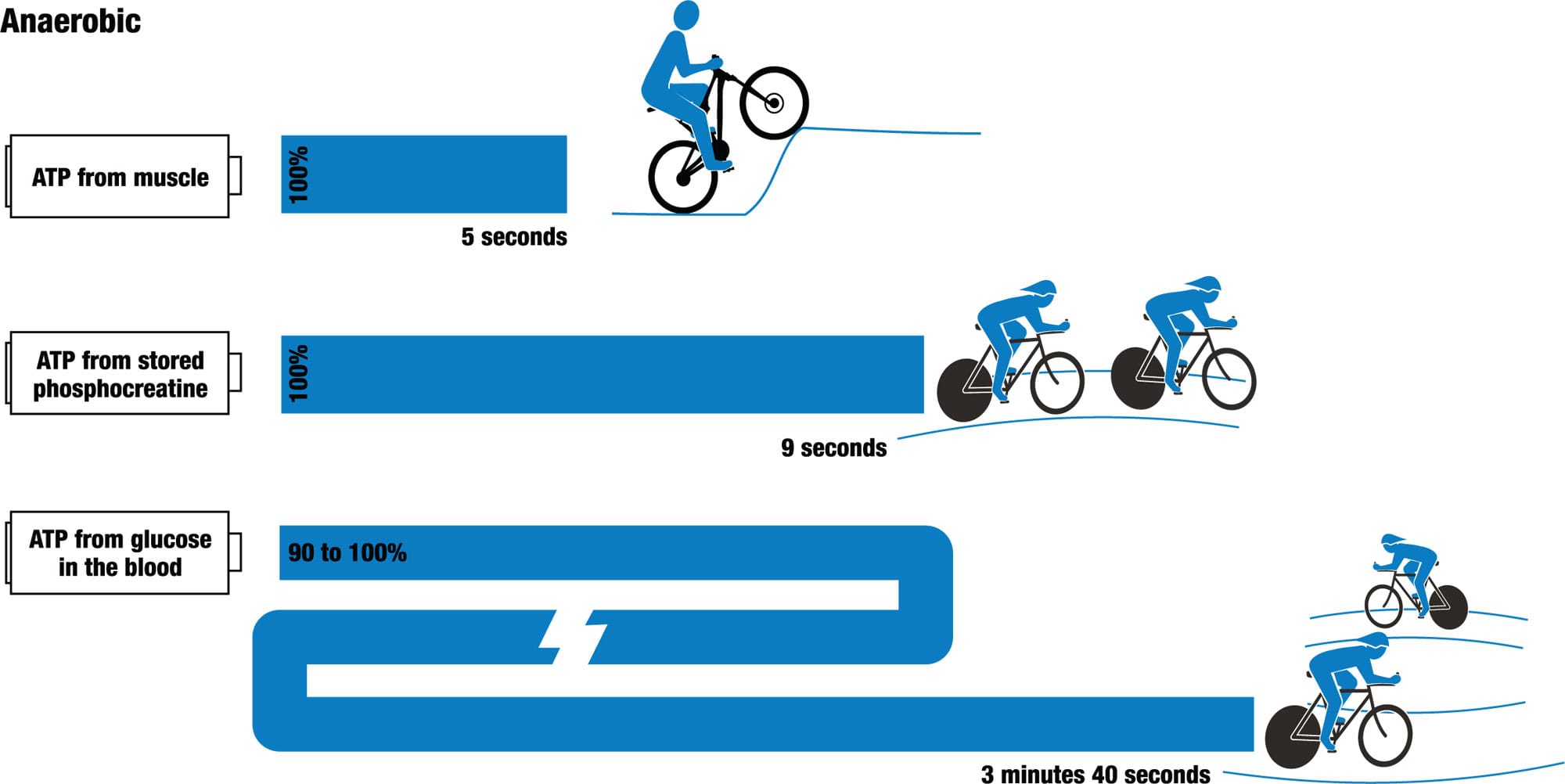
Sustaining physical activity Muscles are fueled by energy released when ATP breaks down, but only a little is available instantly. There are several ways that more can be synthesized over time, and this is what limits the intensity and duration of exercise.
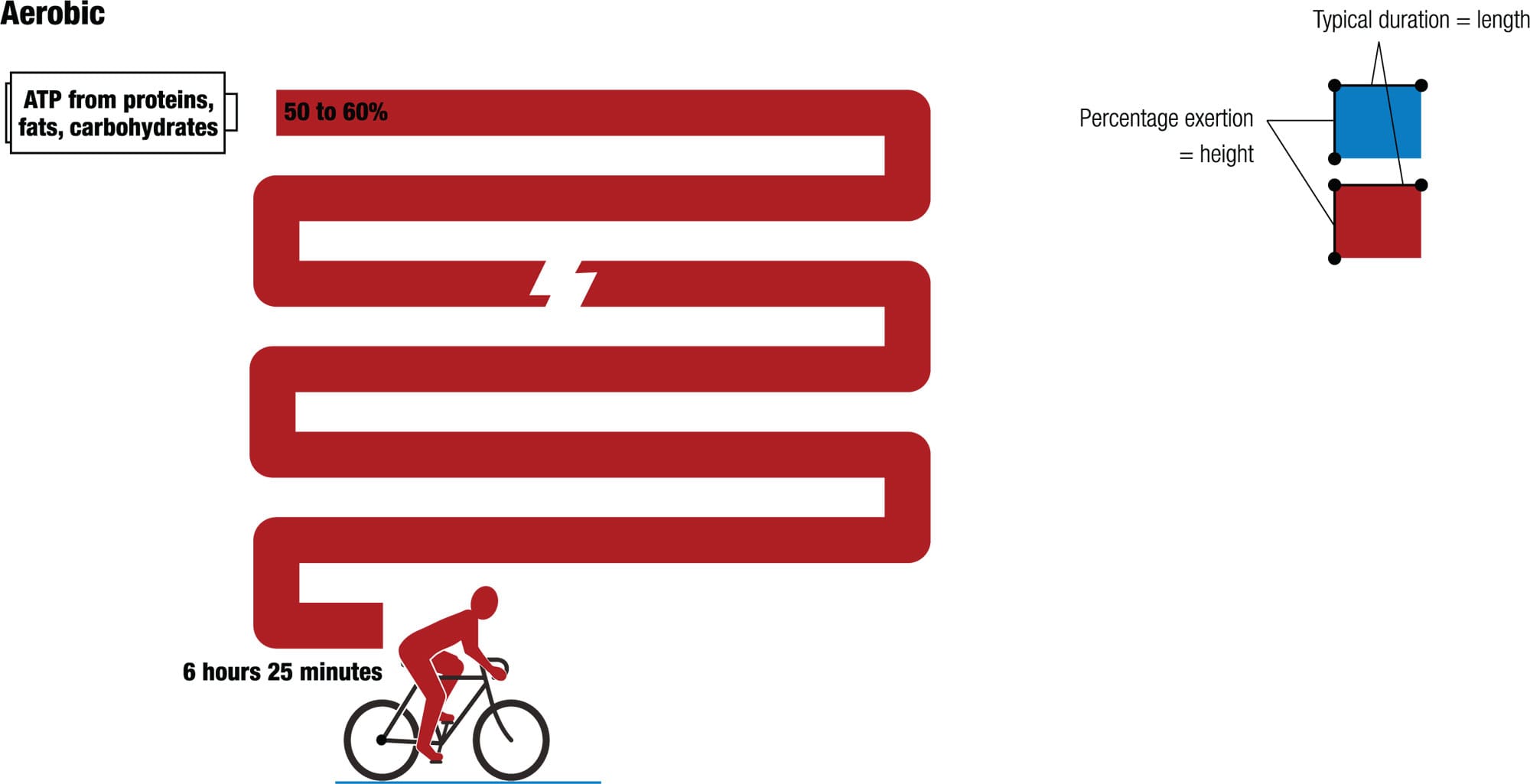
What are fast and slow twitch?
 IIb or not IIb?
IIb or not IIb?
Human muscles contain two different kinds of skeletal muscle fibers—slow twitch and fast twitch. Their names say it all. Slow muscle fibers are best suited to extended periods of activity with low levels of force, such as long-distance riding. Fast twitch fibers are better suited to short periods of vigorous activity such as kicking for the line in a sprint.
Slow (red) and fast (white) fibers behave differently because they have different ways of sourcing and using energy. Slow twitch fibers can quickly access supplies of ATP, the molecule that releases energy, and this makes them able to work for longer without getting tired. They’re what keep cyclists going for hours when commuting, leisure riding, or touring. Fast twitch fibers, on the other hand, get most of their ATP from a less efficient process that quickly causes pain and fatigue. That’s what limits a cyclist’s ability to maintain hill climb attacks and ferocious sprints. The maximum contraction velocity of a single slow twitch fiber is approximately one-tenth that of a fast twitch fiber.13 Fast twitch fibers are more likely to be injured through strain.14 Most muscles contain both slow and fast twitch fibers and although the ratio is thought to be genetically determined, it can be changed through training.15 In fact, there are two kinds of fast twitch fiber—IIa, which operates both aerobically and anaerobically, and IIb, which is active for only a short time, works anaerobically, and tires sooner. Riders who want to increase their count of type IIb fast twitch fibers to help them sprint can start weight training. The process of muscle change is counterintuitive, because weight training can convert type IIb fibers to the more versatile type IIa when sprinters really want a lot of IIb. The trick, however, is to stop training a little while before competition, because then the body seems to reverse the conversions and overshoot, giving the muscle perhaps twice the level of IIb fibers as before training.16
Percentage of muscle fiber types
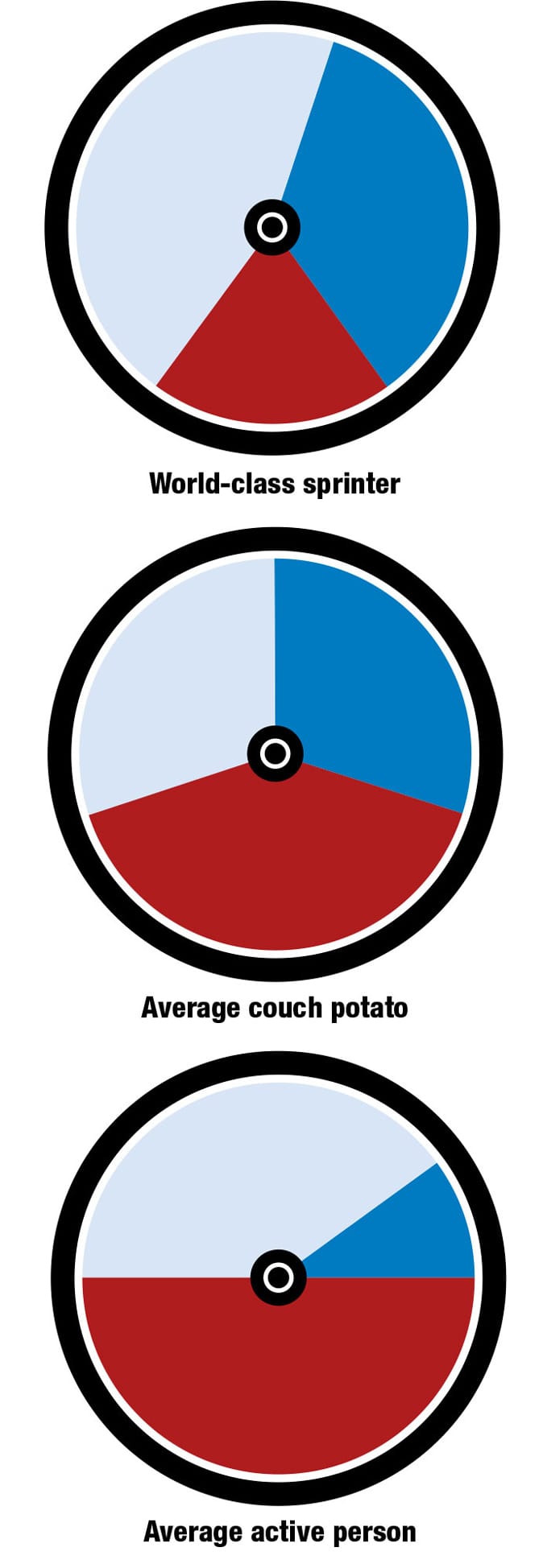
Switch twitch Training can convert one kind of muscle fiber into another, particularly the two types of fast twitch fiber, IIa and IIb. The capacity to change from fast to slow fibers is not so clear.17
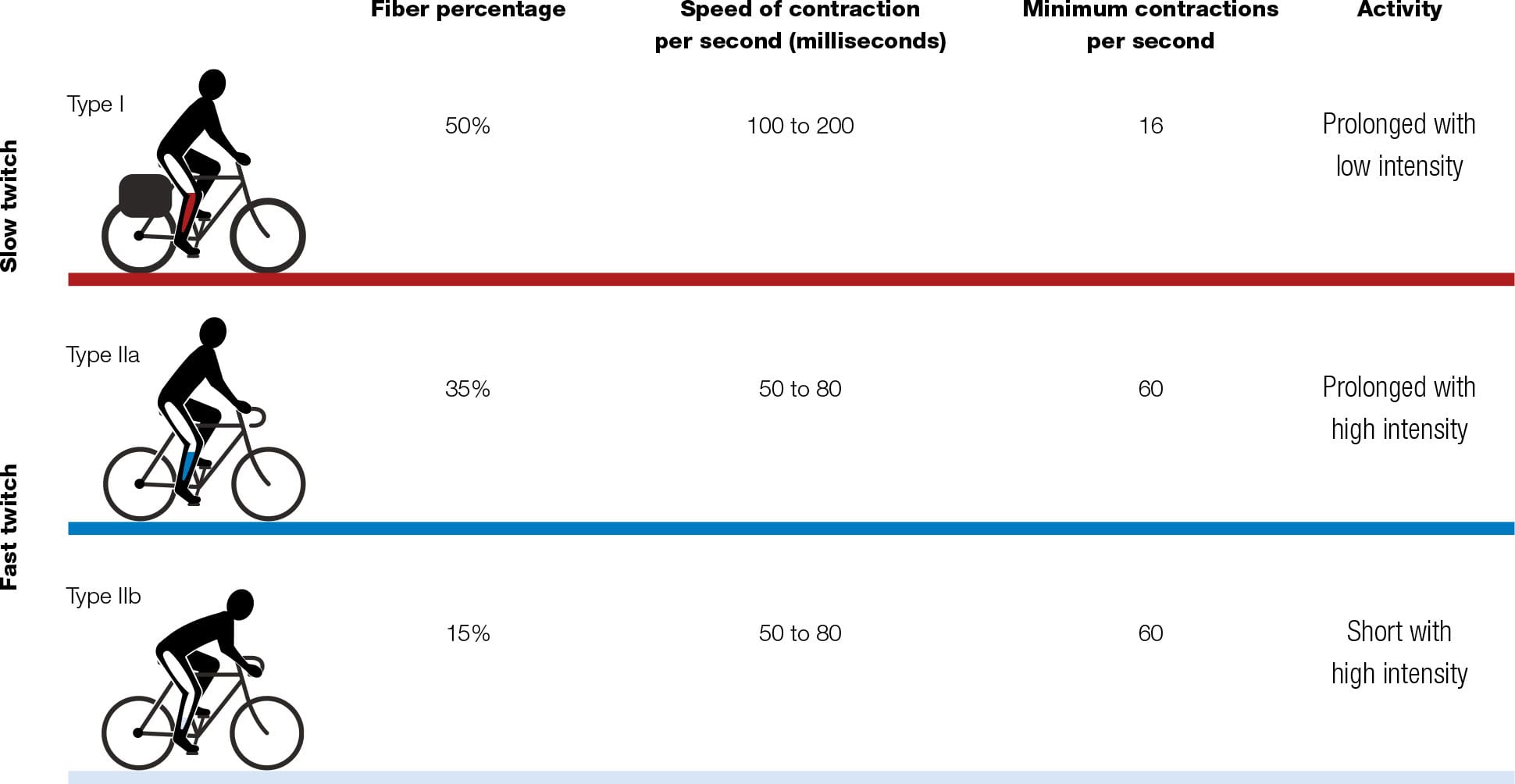
Which twitch? We need both kinds of muscle fiber, but each has its own characteristics which can enhance or limit a cyclist’s performance.18
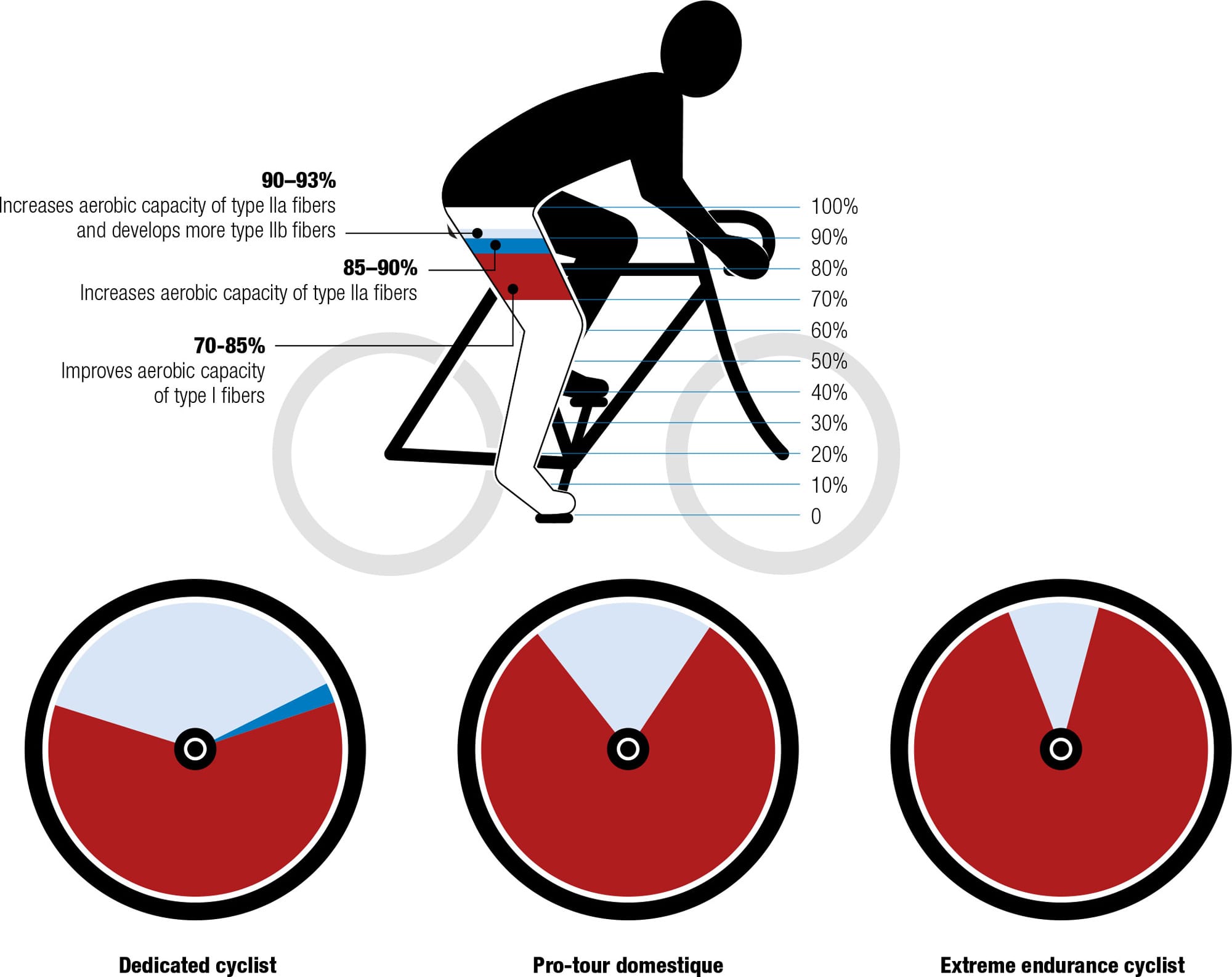
Changing type Riders who want to maximize the aerobic capacity of their type I fibers for endurance cycling train at 70 to 85 percent of their maximal steady-state heart rate. Harder training at 85 to 90 percent can improve the aerobic capacity of type IIa fibers and, at 90 to 93 percent, not only do the type IIa fibers increase their aerobic capacity but the development of more type IIb fibers is also promoted.19
How does breathing affect cycling?
 Can I get some air?
Can I get some air?
Hard cycling demands rapid, deep breathing. That’s because the oxygen most cells need to function must be replenished by the respiratory system. This draws in air by contracting and flattening the diaphragm muscle to reduce pressure in the thoracic cavity of the chest. As the intercostal muscles lift and expand the rib cage, the lungs expand so fresh air flows in. Then the diaphragm relaxes, the chest cavity becomes smaller, and the lungs are squeezed to expel the used breath. Breathing is largely subconscious—although it can be affected by emotions and thought processes—so we can go riding without thinking about breathing at all.
But what about the quality of the air we breathe? Rural cyclists certainly breathe cleaner air, but even riding daily through heavy traffic is better for respiration than driving.27 Through exertion, a cyclist breathes about two to three times as much air as the motorist, but the air is not as polluted as it is inside a vehicle.28 In some cities, cycle commuters can be exposed to more black carbon soot than pedestrians because they’re closer to car exhausts, so it’s better not to follow vehicle paths too closely.29 Luckily, physical exercise strengthens the body’s ability to resist the effects of pollution.
Some aspects of breathing cannot be changed. Total lung capacity depends on weight, sex, and age: tall people tend to have larger lungs than shorter people, and females have smaller lungs than males. Lung capacity decreases with age, so that a cyclist at the age of 80 will have only about half the lung capacity of someone of 20. Whatever a rider’s lung size, only a fraction of the total capacity is used unless the exercise is strenuous. While it’s not possible to make lungs grow bigger, research suggests that specific muscle exercises can improve breathing efficiency, which, in turn, helps cyclists perform better. Experiments in which cyclists have followed training routines to strengthen breathing muscles have made them up to 5 percent faster.
Trained to perform
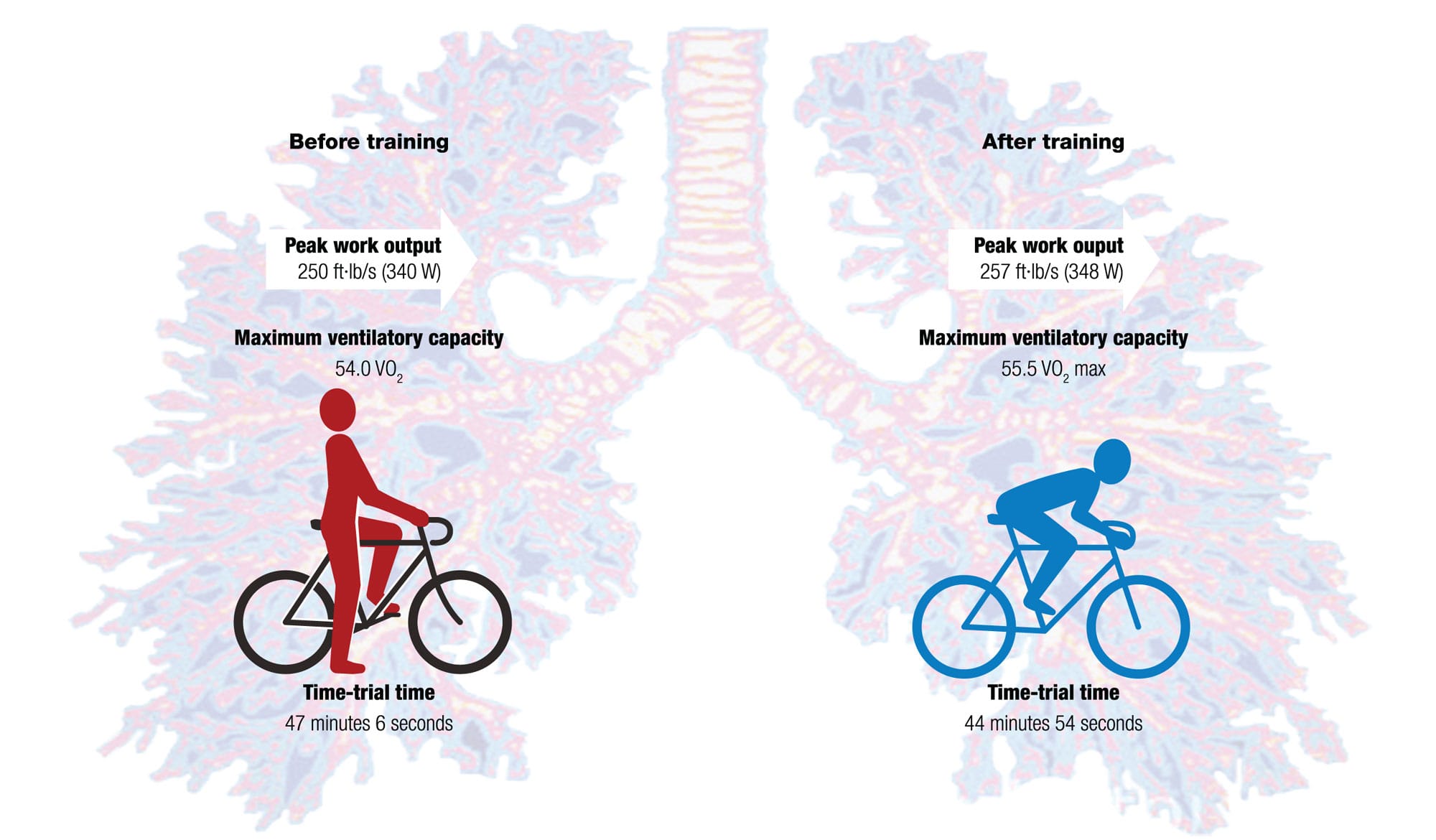
Inspiring research The performance of fit young cyclists was measured before and after they were trained to improve their respiratory muscles. They completed a task that simulated a time trial. Not only did their ventilatory capacity increase significantly but they were about 5% faster in the simulated time trial. A control group given no training and a third group given placebo training showed no such gains.30
The benefits of respiratory training
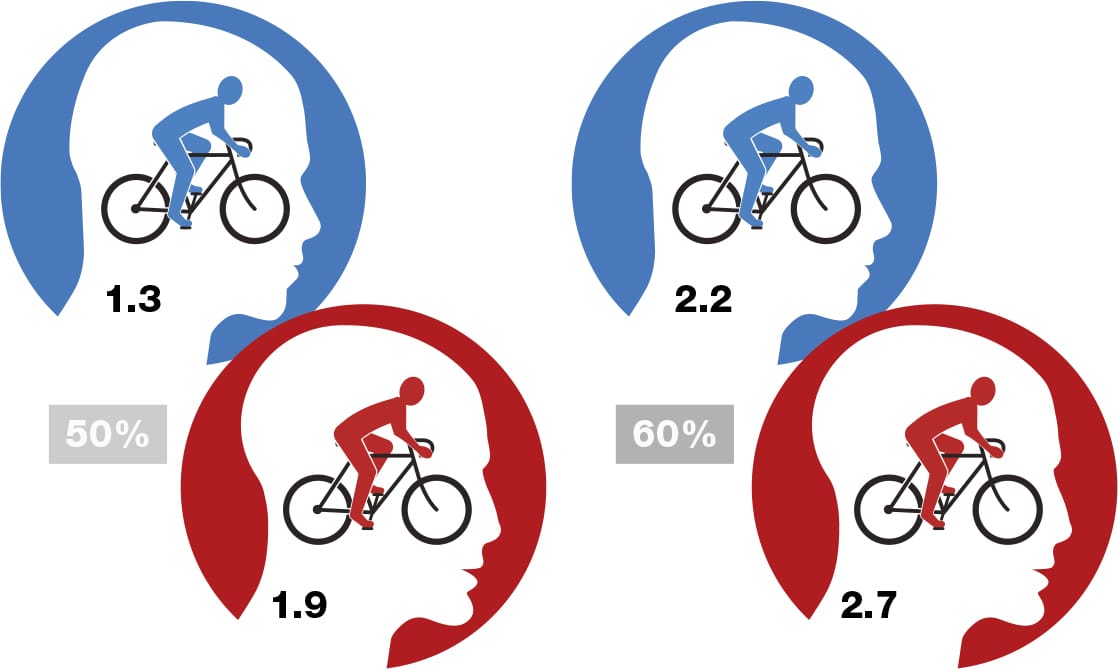
Airheads Whatever difference respiratory training may make to cycling performance, it can make tough rides seem easier. After being trained to improve their breathing, riders felt that pedaling was easier at all workloads. The scores represent the riders’ perceptions of how hard it was to sustain increasing workloads before (red cyclists) and after (blue cyclists) inspiratory muscle training. The higher the number, the harder it was perceived to maintain the workload. The percentages indicate how hard they were actually working in terms of their maximum work rate.31
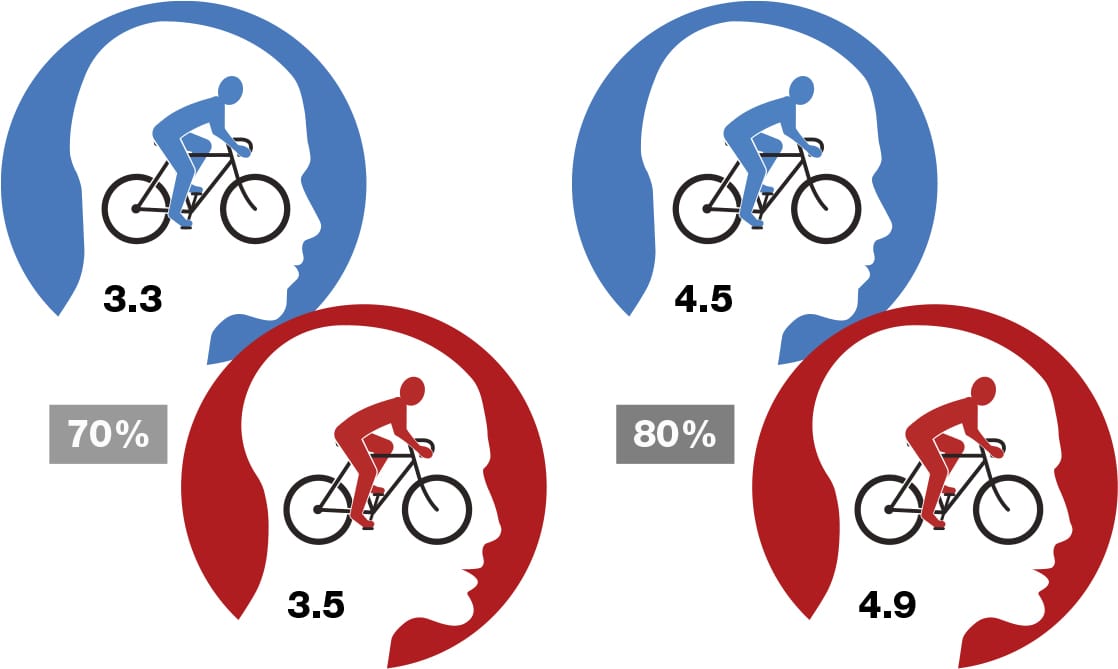
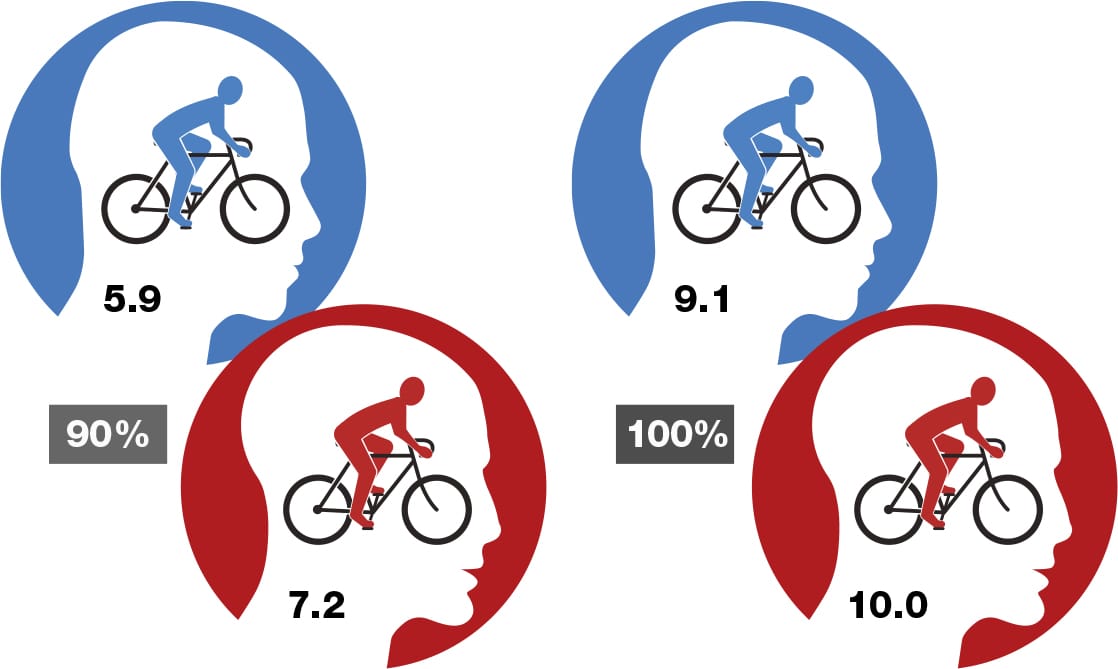
What are the effects of altitude training?
 Will I get a nosebleed?
Will I get a nosebleed?
Altitude adds complexity to training and the benefits are uncertain. The performance of some riders improves—but for others there is no gain at all. Reaction to different atmospheric conditions, pressure, and temperature varies between individuals and even for the same rider on separate occasions. The science is still being worked on, so the one definite about altitude training is: it needs careful monitoring.
It’s generally the case that rides that start low and pass through high altitudes can be difficult for riders who haven’t acclimatized, and not just physically. Research on elite cyclists showed they were significantly more angry, tired, confused, depressed, and tense, and less lively on a two-hour ride in a chamber simulating the atmosphere at 8,200 ft (2,500 m) than during similar rides at sea level. Emotions do play an important role in a rider’s ability to fulfill their potential, and although some athletes can harness the extra anger they feel when riding at unusual altitudes, the research suggests that acclimatization before long mountain stages may be of more help overall.32
Although the proportion of oxygen in the air breathed in at altitude is the same as at sea level, the lower barometric pressure means not as much goes into the blood. The capacity to exercise diminishes as a rider ascends and mountain sicknesses such as headache, dehydration, or even pulmonary edema can be triggered. That’s why it’s advisable to reduce training intensity during the first 7–10 days at altitude. Some riders use special tents and chambers to simulate the conditions at altitude by increasing the atmospheric nitrogen content at the expense of oxygen. The attraction of altitude riding for some is that when they return to lower levels they can tolerate low blood oxygen levels better and cycle harder and faster—especially in short-duration contests such as track sprints.33 Studies suggest high-quality, altitude-inspired performance is sustained at sea level for up to four weeks, although the exact mechanisms and timing are poorly understood as yet.
The effect of altitude on mood

Measuring mood The mood states of eight elite male cyclists were assessed before and during two-hour ergometer rides under low-level conditions and at a simulated altitude of 8,200 ft (2,500 m). Mood was tested using the Brunel Mood Scale; the higher the score, the more intense the mood state. At altitude, riders enjoyed a relatively strong sense of vigor before the ride began, but once the experiment was underway, this soon fell below the usual level felt during a low-level ride.34
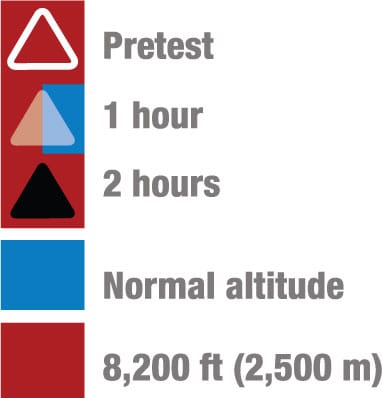
The highs and lows of training

The high life It’s not always necessary to move to mountaintops to start altitude training. Hypoxic tents simulate a high-altitude atmosphere, and supplemental oxygen at altitude can help simulate low-level conditions. Artificial techniques such as these are mixed with combinations of high- or low-altitude living and training to produce various approaches, each with its own practical and physiological advantages and disadvantages.35
1 Live high but train low using natural altitude
Advantages
• Potential for a greater tolerance of hypoxia and endurance performance.
• Living and training in a natural environment.
Disadvantages
• Have to descend for each training session and ascend afterward.
2 Live high but train as if at low altitude by using supplemental oxygen
Advantages
• Can remain in one training venue.
Disadvantages
• The use of oxygen cylinders means only training on an ergometer or rollers is practical.
3 Live high, train high
Advantages
• Maximized opportunity for enhancing hypoxia tolerance.
• Remain in one training venue.
Disadvantages
• Potential loss of training quality due to reduced oxygen flux in high-intensity training sessions.
4 Simulate living high by staying in a hypoxic tent but train low outside it
Advantages
• Can remain in home training venue all year round.
Disadvantages
• Difficult to accumulate enough hours in the tent because more than 12 hours per day is recommended.
5 Live low but simulate training high in a hypoxic tent
Advantages
• Potential for enhanced training quality.
• No loss of oxygen flux in high-intensity training sessions at sea level.
Disadvantages
• Training limited to static exercise on ergometer or rollers.
• Duration of exposure to simulated altitude conditions is insufficient for acclimatization.
Is my heart critical for peak performance?
 Will cycling break my heart?
Will cycling break my heart?
Getting oxygen, glucose, and nutrients to tissues and muscles, removing carbon dioxide, and disposing of acid and other waste products is the job of the cardiovascular system. The heart and lungs are part of the cardiovascular system—and both are very important for cyclists.
The heart is a muscle triggered to contract by regular, automatic nerve impulses. These contractions pump oxygenated blood through the heart’s four chambers (the right and left ventricle and the right and left atrium) and around your body. The more it is exercised, the more effective a heart is. Cycling, like any other exercise, can’t make it exceed its maximum rate, which can vary between individuals from 150 beats per minute (bpm) to 220 bpm. However, regular riding can enlarge the muscle of the left ventricle, the chamber that pumps freshly oxygenated blood into the arteries. This means a larger volume of blood flows around the body with each beat, so a big heart can deliver more oxygen, glucose, and nutrients to tissues that need them. Also, being bigger, it can rest at a lower rate than before exercise. When the resting heart rate is low, the range up to maximum heart rate is greater, so more blood can be circulated, refreshing vital muscles in the legs and other tissue. The resting rate for an average person is 60 to 80 bpm, although it can be much lower—results from the pre-2004 Tour de France medical tests showed that the average rider had a significantly lower resting heart rate.36
Low heart rate is a by-product of training, and so is longer life expectancy. In fact, any cycling that is of at least average intensity, when heart rate is raised to at least half its maximum, decreases the chances of dying from heart disease. That pulsing muscle in your chest gets stronger and is better able to respond to the stresses you put on it every extra day you ride.
Cycling speeds and risk of heart disease
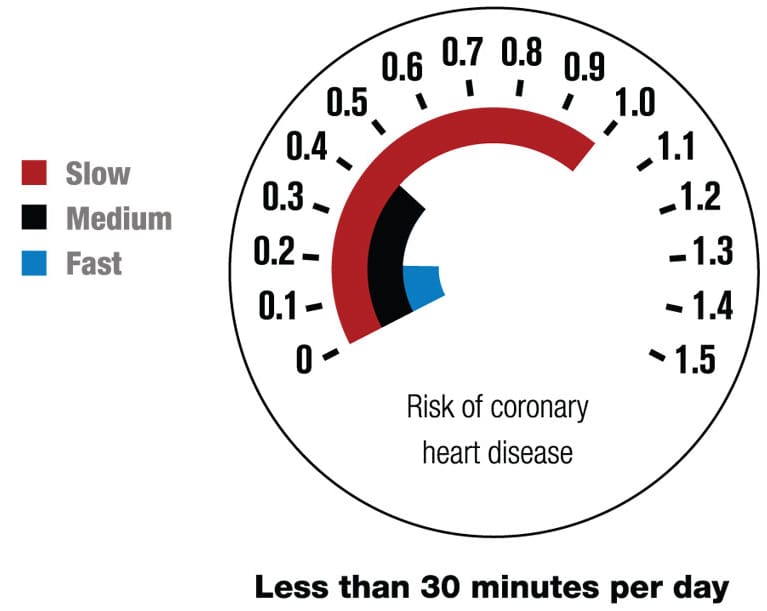
Lower risks Cycling protects against the risk of coronary heart disease, no matter how long you cycle each day—but cycling faster is better. The data from a large population was calculated using a slow cyclist who rides just a few minutes each day as the baseline. (The data also takes into account other factors such as smoking, drinking, and age, which is why it shows high heart disease death risks for people who ride slowly and for longer—they may be less healthy and less physically able already.) The fastest cyclists over each time period have the best heart health.37
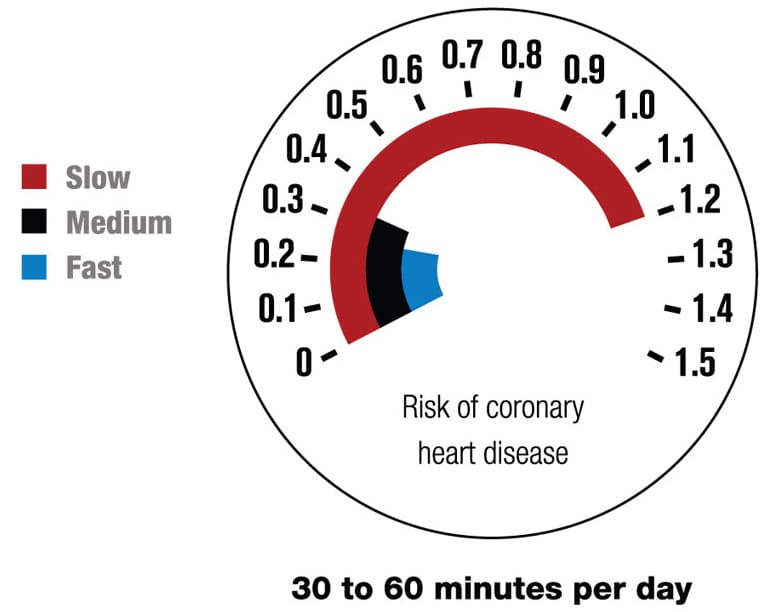
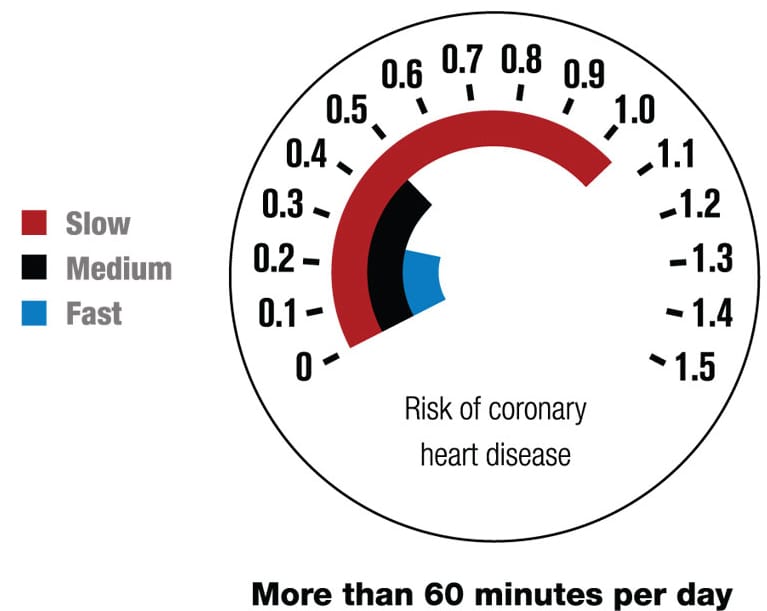
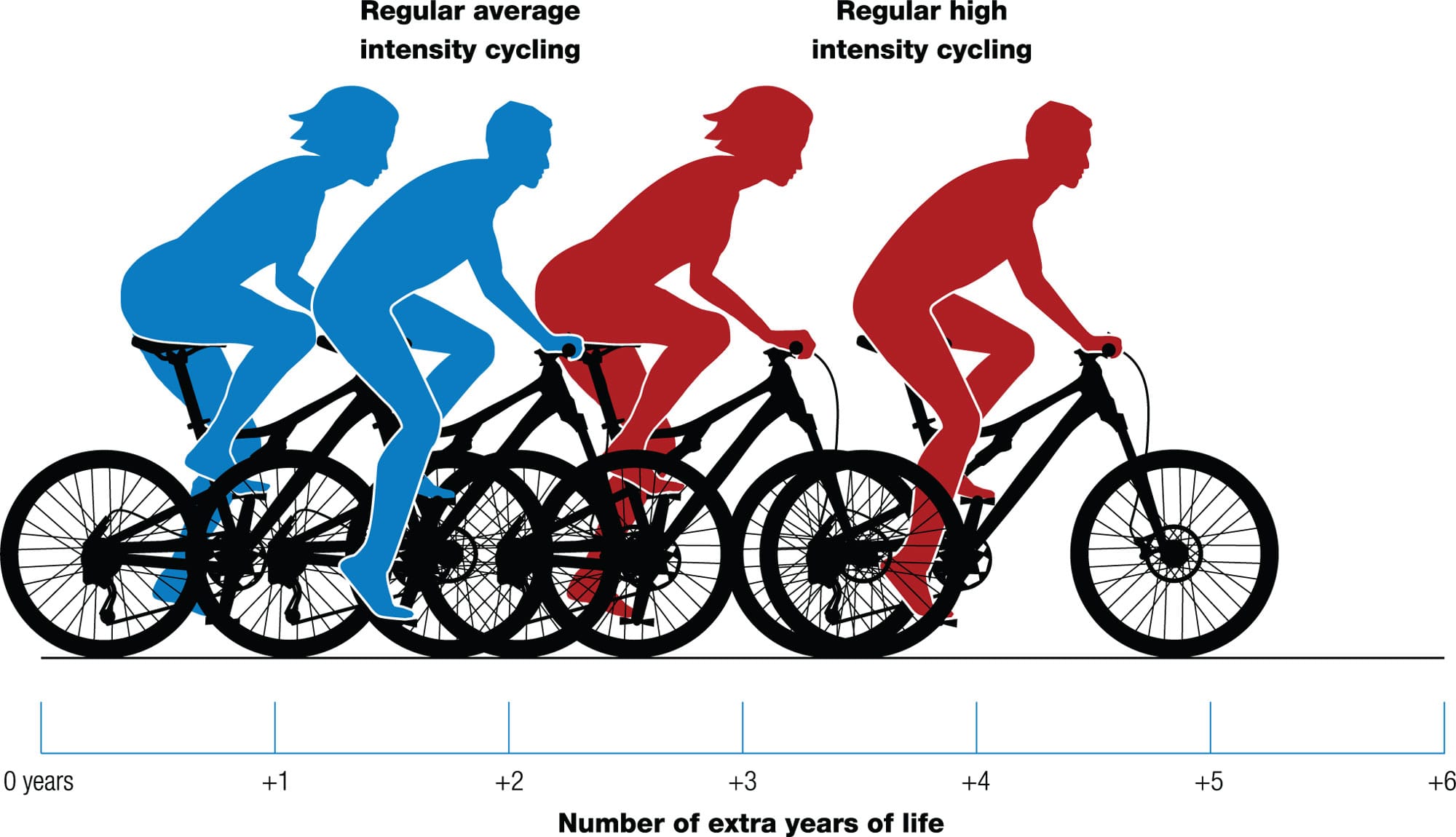
Heart health Scientists discovered that regular cycling improves heart health, but it is the intensity of exercise which is important, not the duration. They tracked more than 5,000 men and women over 18 years and found that those who cycled harder live significantly longer.39
How low can you go?
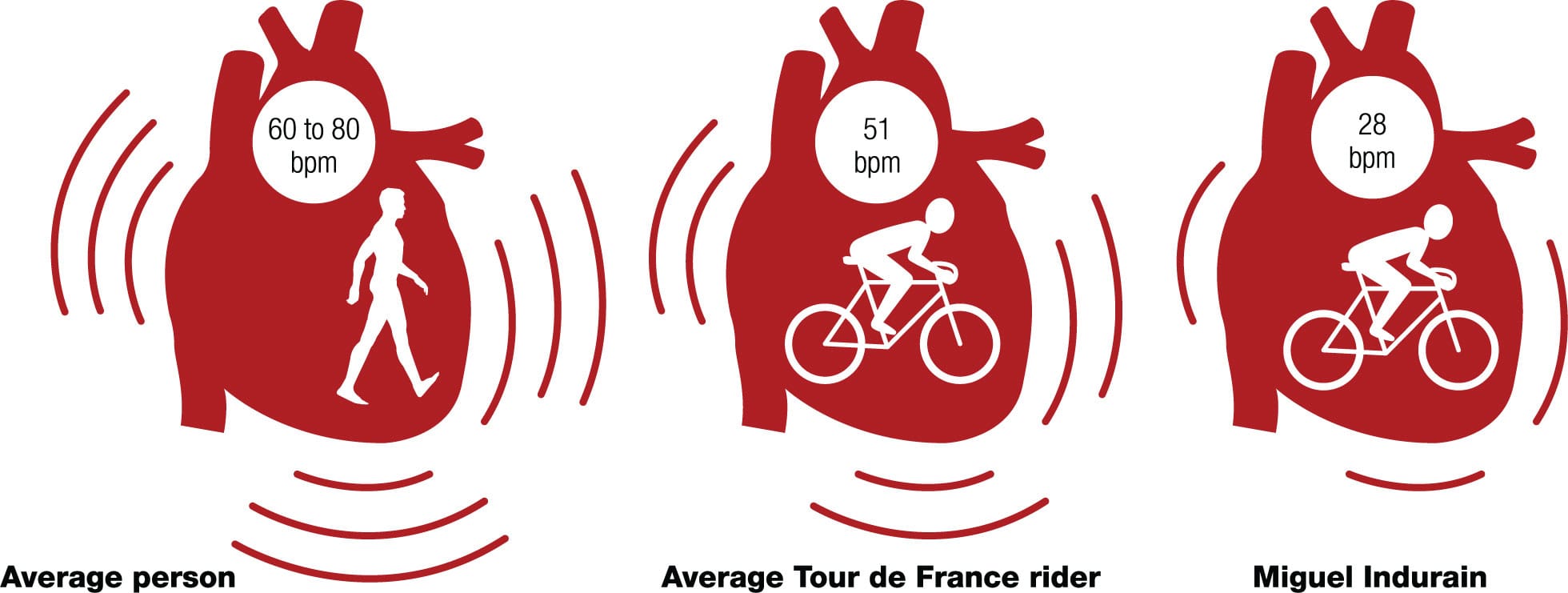
Below average The resting rate for an average rider is 60–80 bpm. Before the 2004 Tour de France, the average resting heart rate of the riders was 51 bpm and in the 1990s Miguel Indurain’s was an extraordinarily slow 28 bpm.38
How does “blood boosting” work?
 When will the cheating stop?
When will the cheating stop?
Scientific knowledge helps cyclists to ride farther, faster, and for longer. It underpins training programs, diet, strategy, and equipment. Unfortunately, it can also be used to help alter the blood of competitors so they can outperform their rivals.
The level of oxygen supplied to muscles can limit the amount of power a cyclist produces. Red blood cells deliver the oxygen to muscles, so ambitious riders have long been keen to raise the levels of these cells. Initially, this was done with a transfusion, known as blood doping. This transfusion could be of someone else’s blood or some of their own extracted previously. This practice was largely abandoned in the 1990s, when biochemists synthesized erythropoietin (EPO), a hormone that stimulates bone marrow to produce more red blood cells. Both doping and EPO are now against the rules of competitive cycling, and stringent checks are made to expose cheats. The benefits of EPO are enormous—it can increase oxygen uptake by 8.1 percent, boost peak power output by 13 percent, and extend performance time to exhaustion by a massive 54 percent—all within four weeks of use.40 These findings probably explain why the speed and power of extraordinary endeavors in major races have never been matched since EPO testing began in 2002.
After EPO detection was introduced, blood doping returned to favor, but new checks have been introduced to counter the trend. Of course, cyclists vulnerable to their own ambition or the greed of their team may be tempted to try any of the hundred or so new EPO-like performance-enhancing drugs that experts say are currently undetectable.41 Instead of competing against each other, these riders would be using their bodies as labs for experiments. Meanwhile, the cycling regulators are engaged in a different race altogether, to work out how to spot the cheats before they claim unfair glory.
“The cycling regulators are engaged in a different race altogether, to work out how to spot the cheats before they claim unfair glory.
Does skin really affect riding efficiency?
 Should I shave my eyebrows as well?
Should I shave my eyebrows as well?
The increasingly popular World Naked Bike Ride is a form of political activism, but it also highlights how significant skin is. Skin defends us from physical, chemical, and microbial attacks, and protects vulnerable tissues and organs. It regulates our body temperature and uses sunshine to make vitamin D. It may be less fashionable than Spandex, but it constantly renews itself and lasts a lifetime.
A network of nerve cells in your skin gathers valuable data about airflow, temperature, and pressure changes while you are riding. If the data reveals a headwind, this can prompt you to adopt a more streamlined position. If your skin senses a tailwind, you might sit up. Pressure receptors in the contact points of the feet, hands, and buttocks alert riders to the best path for a smoother ride. Off-road riders learn from the pain receptors in the skin not to ride too close to bushes or tree branches.
Skin also plays an important role in temperature regulation. There is evidence that well-trained cyclists subconsciously alter the intensity of their exercise according to skin temperature.44 If the ambient temperature drops (perhaps if the sun goes behind a cloud), skin can insulate the body. The dermis-based arrector pili muscles cause body hairs to stand up and trap a layer of insulating warm air. Conversely, on hot rides your skin acts as a radiator, emitting excess heat. When the ambient temperature is high, eccrine glands all over the body can release salty water (sweat), which evaporates and promotes heat loss. It’s more comfortable to wear shorts and leave your legs uncovered so the heat can escape. Shaving your legs won’t promote heat loss, but it does make it easier to treat wounds and get massages that make your skin feel better.
Muscles and skin temperature
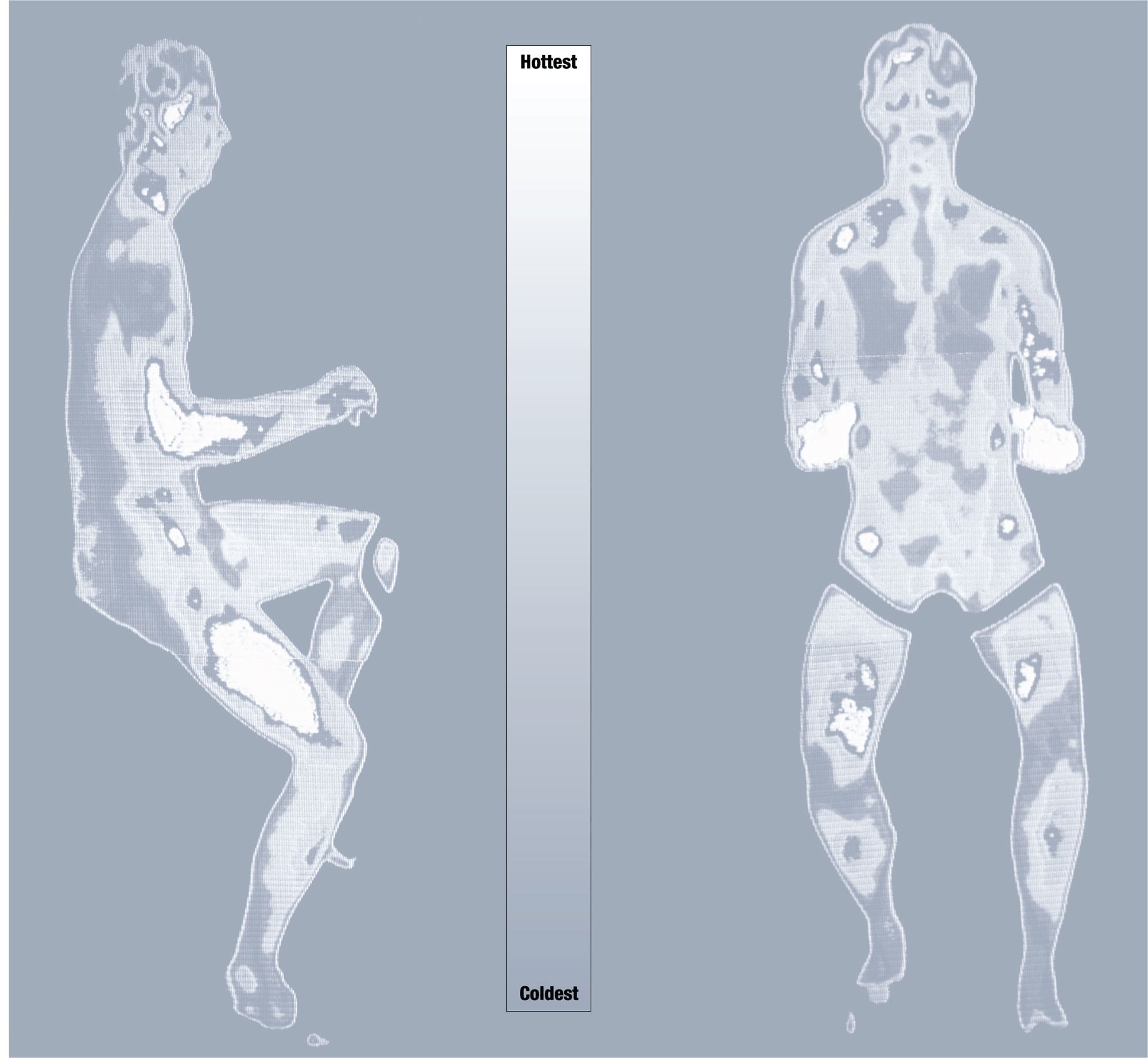
Surface protection These thermograph images show the variation in skin temperature of a man on an exercise bike; the muscles warm up through work, and this heat is emitted via the skin. The coldest areas are darker, while the hotter areas are in white.
Skin temperature and power output

Sensitive skin Skin temperature can influence how hard a cyclist works, at least for the first 15 minutes of a ride. A sophisticated experiment that used water jackets to change a rider’s skin temperature without altering the ambient temperature showed that a rider who starts with hot skin generates significantly less power than a rider who starts cold. The initial discrepancy quickly disappears, however, and the power outputs of the two riders gradually converge and meet at 50 minutes, even though the trends in their skin temperature are in opposite directions.45
equipment: the human body
The bicycle is designed to fit the body of Homo sapiens, a complex organism that has evolved over millions of years. Even if our earliest ancestors had invented the wheel and fabricated metals, they would have had difficulty riding a modern bike because they themselves were built differently. They had skeletons, muscles, and brains sized and optimized for another, more primitive, world. Chimpanzees are among our closest relatives, but a chimp can’t rotate its thumb to squeeze it against their fingertips—so unscrewing tire valve caps and tightening spoke nipples would be a problem. Even the earliest hominids may not have had this ability.
The dividing line between hominids and great apes is our larger brain size and the ability to stand upright. The earliest evidence of a species that could walk without using its knuckles is Orrorin tugenensis, which lived six million years ago. The size of a chimp, Orrorin tugenensis could possibly have mastered a child’s tricycle, although one strengthened to withstand its 65–110 lb (30–50 kg) weight. Three million years ago, Australopithecus afarensis emerged in Eastern Africa. This species survived for almost a million years with a brain one-third the size of ours, with an average male height of 4 ft 11 in (151 cm) and females at 3 ft 5 in (105 cm). With a relatively long torso and limbs all the same length, the frame of their bike would need to be long and low. A recumbent might have fitted.
The oldest early humans with proportions similar to ours, and potentially able to cycle, were Homo erectus. Their legs were elongated and their arms shorter compared to the length of the torso. A little lighter than average modern humans, they ranged from 4 ft 9 in to 6 ft 1 in (145–185 cm) tall, and could not only walk but also probably run. They became extinct some 143,000 years ago. The short and stocky Neanderthal (Homo neanderthalensis) of Europe, who may have still been around 30,000 years ago, might slog through a modern cyclo-cross race, but would lose out to its longer-lasting neighbor Homo sapiens, who first evolved 200,000 years ago and eventually took to cycling 150 years ago.

What factors most affect riding speed?
 What will make me go faster?
What will make me go faster?
The information in this book will help you as a cyclist to make better decisions about what, where, when, and how you ride. While most cyclists want only to arrive at their destination safely, with a modest amount of effort and at a reasonable cost, others strive for strength and speed. In both cases, a knowledge of the science underpinning riding a bike makes it easier to strike the optimum balance.
There is a peloton of options for riders who are determined to use their energy to cycle faster—and this book could be twice as long yet still not cover all the potential methods. National and professional cycling teams have full-time staff dedicated to identifying tiny details to make riders go quicker, but, for the average rider, too much information can distract from what they like best—riding their bikes. So we’ll end with a summary of the most accessible alternatives and the likely gains they could bring over a ride of 25 miles (40 km). Don’t take the recommendations as immutable and infallible. By now, you’ll have gathered that every cyclist, every route, and every ride is different every day—so, while cycling obeys the laws of nature, there are too many variables to be 100 percent certain the chosen input will produce the desired result. After all, when was the last time you accurately predicted a puncture?
Bad luck plays a part in cycling as it does in all aspects of life, but this research shows overwhelmingly what a champion from another sport, golfer Arnold Palmer, said: “The more I practice, the luckier I get.” Training conditions the body to give the best performance possible, and allows you to enjoy the ideal way to travel—cycling.
Potential time losses for a 25-mile time trial

Go slow It’s too easy to go slower than you want. You don’t need to have read this book to know that it’s harder to pedal a heavier bike and an overweight body than lighter versions of both. Interestingly, however, the time losses incurred from extra weight pale in comparison to those from an unaerodynamic shape.
Potential time losses for a 25-mile time trial

Train hard or invest? How much faster could you ride if you had access to the best training and the top equipment? Taking the example of a 25-year-old male weighing 154 lb (70 kg) riding a 25-mile (40-km) time trial course on a 22 lb (10 kg) bike with aero wheels and an aero helmet, it’s clear that the novice without money is better off training hard. If they have cash to spend, then investing in aerodynamics will reap rewards, as it does for the elite cyclist. The novice cyclist is assumed to be traveling at 20.45 mph (32.91 km/h) for a total time of 1 hour 12 minutes 56 seconds, while the elite cyclist will cover the 25 miles in 52 minutes 2 seconds at an average speed of 28.66 mph (46.12 km/h).46
